
Search Product category Any value Sample Label 1 Sample Label 2 Sample Label 3

How to Write a Brewery Business Plan: Complete Guide
- January 3, 2023
- Food & Beverage
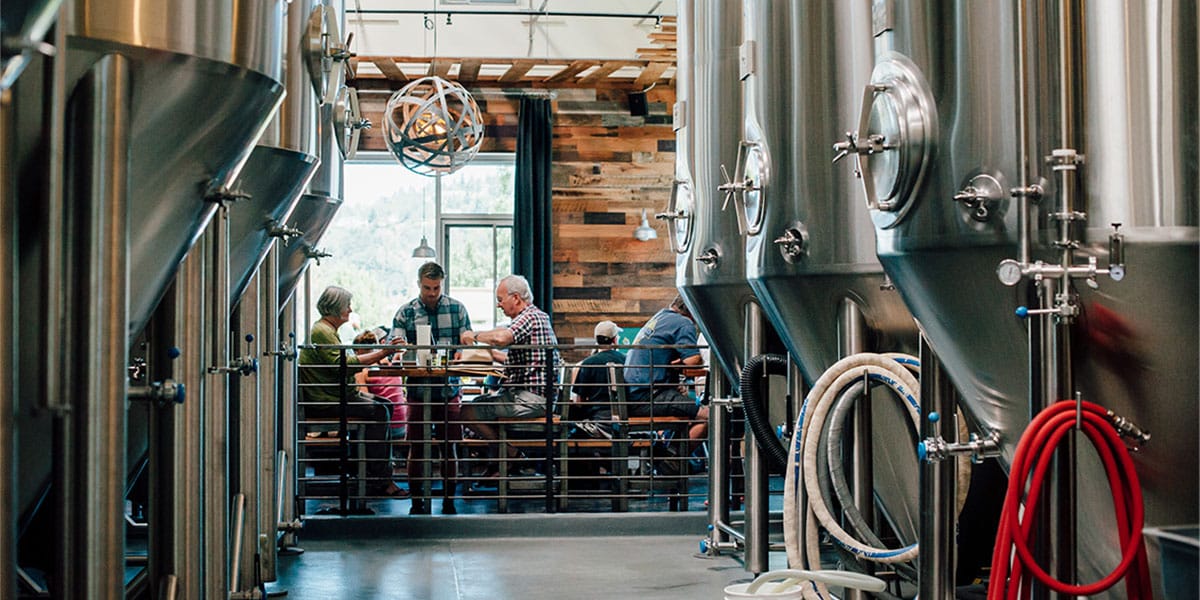
Whether you’re looking to raise funding from private investors or to get a loan from a bank (like a SBA loan) for your brewery, you will need to prepare a solid business plan.
In this article we go through, step-by-step, all the different sections you need in the business plan of your brewery. Use this template to create a complete, clear and solid business plan that get you funded.
1. Executive Summary
The executive summary of a business plan gives a sneak peek of the information about your business plan to lenders and/or investors.
If the information you provide here is not concise, informative, and scannable, potential lenders and investors will lose interest.
Though the executive summary is the first and the most important section, it should normally be the last section you write because it will have the summary of different sections included in the entire plan.
Why do you need a business plan for a brewery?
The purpose of a business plan is to secure funding through one of the following channels:
- Obtain bank financing or secure a loan from other lenders (such as a SBA loan )
- Obtain private investments from investment funds, angel investors, etc.
- Obtain a public or a private grant
How to write your brewery’s executive summary?
Provide a precise and high-level summary of every section that you have included in your business plan. The information and the data you include in this segment should grab the attention of potential investors and lenders immediately.
Also make sure that the executive summary doesn’t exceed 2 pages in total: it’s supposed to be a summary for investors and lenders who don’t have time to scroll through 40-50 pages, so keep it short and brief.
The executive summary usually consists of the five major sub-sections that include:
- Business overview : this segment will provide a high-level summary of your business and the products you will sell. For example, mention the type of brewery you want to open (such as microbrewery, brewpub, taproom brewery, regional brewery, contract brewing company, etc.). Also, briefly mention your products and services (if you offer a sit-in taproom for example) and pricing strategy
- Market analysis : summarise the market where you will operate and provide a brief about the target audience , market size , competitors, etc. No need to provide granular data here, save it for the Market Overview section later on (or the appendix). You must provide only scannable data points to keep potential investors and/or lenders hooked.
- People : introduce your brewery’s management and employee structure. Provide a brief (no more than a couple of sentences each) of the knowledge and experience of the team. Also, speak about your hiring plans.
- Financial plan : how much profit and revenue do you expect in the next 5 years? When will you reach the break-even point and start making profits? You can include here a chart depicting your key financials such as revenue, gross profits, and net profit
- Funding ask : what loan/investment/grant are you seeking? How much do you need? How long will this last?
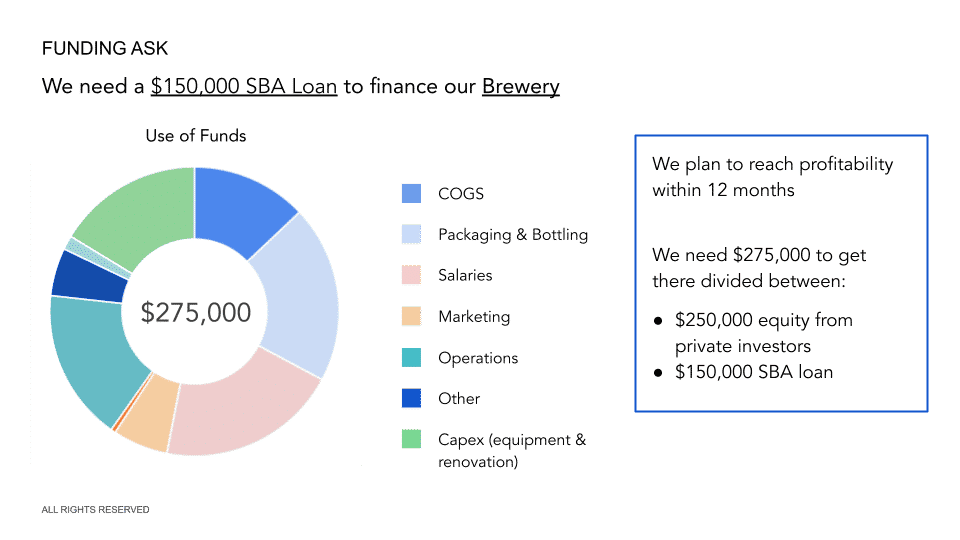
Brewery Financial Model
Download an expert-built 5-year Excel financial model for your business plan
2. Brewery Business Overview
This is the section where you will provide details about your brewery and the chosen business model. You must address some important questions that lenders and/or investors generally ask. Here is a quick list of some of those questions you must address:
- What’s the brewery’s location and why did you select that location?
- Why did you select the type of brewery you want to open?
- What will be the beer products you will offer? Any other drinks or services?
- What will be your pricing strategy and why?
- Who is your target audience?
- How many customers can you serve at once (in case you are going for options like taproom brewery or brewpub)?
- What will be the legal structure of your company?
Let’s look at different subsections that you must include:
a) History of the Project
Any business must have two components:
- Passion & experience of the business owner
- Rationale behind starting this type of business today
Passion & experience
You may or may not have prior experience. If you have experience, speak about it and how it will help you to run your business. For instance, you may have been a brewmaster in a popular brewery for 12 years, and now you want to start your own brewery and use your knowledge to run it more efficiently.
However, if you don’t already have experience, that’s fine. You must demonstrate your passion and some industry knowledge that you have acquired through intensive research.
Is there a certain problem (or perhaps, a set of problems) that your brewery will try to solve when it comes into existence? For instance, there may not be any brewpub in the area, and you want to capitalize on the opportunity.
However, you must understand that the market must be suitable for the business. For instance, if the target audience in the location prefers a taproom brewery, offering a brewpub instead may not be a wise decision.
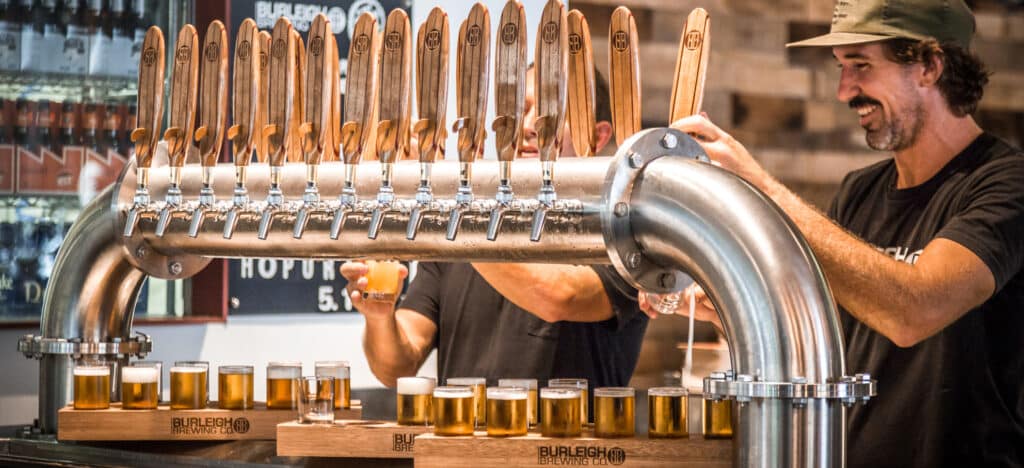
b) Business Model
This sub-section of the Business Overview will explain your business model. Describe the following points briefly:
- Will you buy an existing brewery and do some remodeling, or will you start a new brewery and design it from scratch?
- The type of brewery you want to open and why
- Equipment, inventory, and storage facilities that are essential for the brewery to operate successfully
There are multiple types of breweries that you can consider:
- Nano brewery : This is the smallest type of brewery. There are no defined barrels per annum, but they produce a very limited amount of beer per year
- Microbrewery : This type of brewery will produce less than 15,000 barrels of beer a year. Most beer is sold onsite instead of using distributors. These breweries are typically independently owned
- Brewpub : A restaurant and brewery hybrid in which the beer produced is served to the bar customers
- Taproom brewery : These are professional breweries that sell beer onsite and even via distributors. However, there are no restaurant services available. Sometimes, such breweries will have attached taprooms
- Regional brewery : These are breweries that produce anywhere between 15,000 and 600,000 barrels of beer a year
- Contract brewing company : In this form, a company will hire other breweries for beer production and packaging. However, the marketing and distribution of the beer will be the responsibility of the hiring company
The type of brewery that you want to open will depend on its market size, target audience, your business expansion plans, etc. For instance, if you want to sell your products outside of your state, you may want to go for a regional brewery or perhaps, settle for a contract brewing company.
c) Products & Services
Since you want to start a brewery, you will obviously be selling beer. However, you may decide to make different flavors. Also, if you want to open a brewpub, you may also be running a full-scale restaurant and serving food to your customers.
Depending on the type of brewery you will open, you must list all the products and services that you will sell. For example, if you are selling packaged snacks (taproom brewery) or instead if you want to have a full-service kitchen (brewpub), mention the relevant products here.

d) Pricing Strategy
In this segment, you must explain your pricing strategy. The price of the beer will depend on the product itself and its manufacturing complexity. Even the raw materials and the scale of your business will also determine the pricing.
If you are creating a premium line of products with a higher price tag, make sure that there is a proper justification for that.
It is a good practice to include a pricing chart for all possible products if you have a small menu. However, if you are offering many products, provide a sample menu with the pricing range.
3. Brewery Market Overview
A complete understanding of the market where you want to operate is important for the success of your business.
For example, if you want to open your brewery in an affluent area where people don’t mind spending extra in exchange for a unique craft beer, a specialty taproom brewery may be a successful business.
Therefore, you must cover here 3 important areas:
- Brewery Industry Status Quo : how big is the brewery industry in your area? What is its growth rate (or decline rate) and what are the factors contributing to its growth or decline?
- Competition overview : how many competitors are there? How do they compare vs. your business? How can you differentiate yourself from them?
- Customer analysis : who is your target audience? What type of breweries do they prefer? How regularly do they visit breweries? Do they prefer to sit and eat in a brewery, and if so, do they prefer brewpubs or do they prefer taproom breweries? How much do they spend on average?
a) Brewery Industry Status Quo
How big is the brewery industry in the us.
According to Brewers Association , the overall beer market in the US is $100 billion, while craft beer accounted for 27% market share ($26.8 billion).
After a decline of 9% in 2020, primarily due to the COVID-19 pandemic, the beer industry bounced back by 8% in 2021.
However, what’s interesting is that the overall number of breweries in the U.S. increased in 2021 and reached an all-time high of 9,247 breweries (+2.5% vs. 2021) of which the breakdown (in terms of production volume) is shown below:

How big is the brewery industry in your area?
Once you provide the overall picture of the US, divert your attention to the area where you want to operate. It might not be possible to find region or area-specific studies, and hence, you must estimate the size of your market yourself. For more information on how to do so, read our article on how to estimate TAM, SAM and SOM for your startup.
For example, there were 9,247 craft breweries in the US accounting for $26.8 billion in sales. Hence, the average annual revenue for each craft brewery stood at about $3,000,000.
Therefore, if there are 18 craft breweries in your area (city or region), the overall brewery market size is approximately $54 million.
How fast is the brewery industry growing in the area?
After market size, you must look into the growth rate of the brewery industry in your area. This information may not be available via online research papers. However, assessing the growth rate of the brewery industry can be assessed using the number of competitors in the area.
For instance, if there were 13 breweries in 2018 and 18 breweries in 2022, the average annual growth rate of the brewery market in your area is 8.3%.

What are the current brewery market trends in your area?
It is vital to understand the trends of the brewery industry in your area. Understanding trends will allow you to devise marketing strategies.
Understanding trends won’t be easy. You must conduct research and talk with your target audience. Additionally, you must also study your competitors to understand their target audience, the products they sell, etc.
Some common questions you may ask the target audience include:
- What type of breweries do they prefer?
- At what time of the day do they prefer to visit a brewery (evening, afternoon, late night)?
- How frequently do they visit breweries?
- What type of foods do they usually order along with beer (if they are going for taprooms having a partnership with food trucks or they are opting for brewpubs)?
You can ask as many questions as you need to understand the evolving trends.
b) Competition Overview
Studying your competitors’ business models is vital. You need to understand what makes them successful or why they fail. A clear understanding of their brew offerings, marketing strategies, etc., will allow you to provide a better service.
If your competitors are offering nearly the same products & services, then what is their market share and how do they market their products & services to attract new customers?
It is always a good idea to do some research (if necessary, physically visit your competitors without revealing your business intentions) and create a comparative table summarizing their product & service offerings, marketing strategies, target audience, etc.
Here is a sample table that you can use:
The table you will create will depend on what information you need and want to include based on your proposed business model.
Brewery SWOT Analysis
It’s always good practice to provide a SWOT analysis as part of the business plan for your brewery. It must be crisp and highly focused. SWOT stands for Strength, Weakness, Opportunities, and Threats.
Here is a sample that you can use as a reference:
- Strengths : 8 years of brewmaster experience in a reputed large (non-craft) brewery
- Weaknesses : Startup cost, zero reputation
- Opportunities : An affluent neighborhood with rising demand for a brewpub, no brewpub in a 2-mile radius
- Threats : Increasing cost of raw materials, mass-production beer manufacturers are flooding the market
A clear understanding of your strengths and weakness along with opportunities and threats in the real market can help you to design your marketing strategy. It also helps potential investors to assess the risk and reward profile of your business and is often a must have in your brewery business plan.

c) Customer Analysis
This is the sub-section where you will provide a detailed analysis of your target audience. You will expand the data points your provided earlier in the Business Overview segment.
Some important points that you must include in your customer analysis include:
- Age and gender distribution (you can get local demographic data from census.gov )
- Per capita expenditure on beer
- Frequency of brewery visits
- Average monthly income and disposable income
- Average bill size per visit
- Average yearly or monthly spending on breweries
- Type of breweries preferred
- The expected price range for brews
- Inclination towards loyalty programs
- Things they dislike about existing breweries and what they expect to be improved
You can add as many data points as required to validate your business decision. The idea here is to display your deep understanding of the target audience and their needs, preferences, and expectations. This knowledge can help you to tailor your products & services to attract new customers.
4. Sales & Marketing Strategy
This is the segment where you outline the customer acquisition strategy of your brewery. Try to answer the following questions:
- What is your USP ?
- What are the different marketing strategies you will use?
- How do you intend to track the success of your marketing strategy?
- What is your CAC or customer acquisition cost?
- What is your marketing budget?
- What introductory promos and offers do you intend to provide for attracting new customers?
Let’s expand a bit on a few questions below:
What marketing channels do breweries use?
Marketing channels are ways of communication businesses use to attract customers. Logically, not all breweries use the same marketing channels. For example, a taproom that sells craft beer will most likely rely more on social media and signage vs. a regional brewery that only sells to resellers, restaurants, bars and other business customers (they will likely use a sales team instead, along with some paid media, print ads in specialized magazines, etc.).
See below a few examples of marketing channels that breweries typically use:
- Sales representatives (only breweries selling to businesses)
- PPC ads, Facebook ads, etc.
- Customer interaction through social platforms like Instagram, Facebook, etc.
- Email marketing
- Loyalty programs
- Word of mouth, recommendations
Of course, it’s not mandatory to use all channels. Instead, you can start by focusing on a few of them, and add others as you scale up later on.
Also, you must have a fair and nearly accurate estimate of your marketing budget. Failure to display a well-planned and adequate cash flow for advertising and marketing can lead to investors losing confidence. That’s because investors are fully aware that if adequate funds are not allocated for marketing, the business will be derailed before becoming a success.

What is your unique selling proposition?
In other words, how do you differentiate yourself vs. competitors? This is very important as you might need to win customers from competitors. A few examples of USPs are:
- Quality of beer products : your craft beer(s) may be of higher quality (raw materials r transformation) vs. your competitors’
- Location : your brewery may be located closer to your customers, reducing transport costs for your customers
- Partnerships : you may have partnered with famous brands, bars, restaurant chains or franchises your customers are fond of
- Price : your beer products (and/or food if you have a brewpub) may be cheaper vs. competitors
- Extra products / services : you may be the only brewpub in the area offering food to your customers, whilst all other competitors only offer taprooms
Your USP will depend on your business model, competitor analysis , target audience, and product. The idea is to speak to customers’ emotions and needs. Whatever your USP be, it should appeal to your potential customers and attract them. Plus, The USP you offer should be convincing enough for investors and lenders.
5. Management & People
You must address two things here:
- The management team and their experience/track record
- The organizational structure: different team members and who reports to whom?
a) Management
Small businesses often fail because of managerial weaknesses. Thus, having a strong management team is vital. Highlight the experience and education of senior managers that you intend to hire to oversee your brewery business.
Describe their duties, responsibilities, and roles. Also, highlight their previous experience and explain how they succeeded in their previous roles.
It is also important that you explain how their experiences and qualifications help you in implementing the brewery you are proposing. If they have specialized training, and experience (such as a certificate in brewing technology covering concepts like wort production, fermentation, etc.; brewmaster experience, etc.), add that information.
b) Organization Structure
Even if you haven’t already hired a brewer, head brewer (or brewmaster), tasting staff, tasting room manager, marketing personnel, quality control personnel, and other relevant staff members, you must provide a chart of the organizational structure defining the hierarchy of reporting.
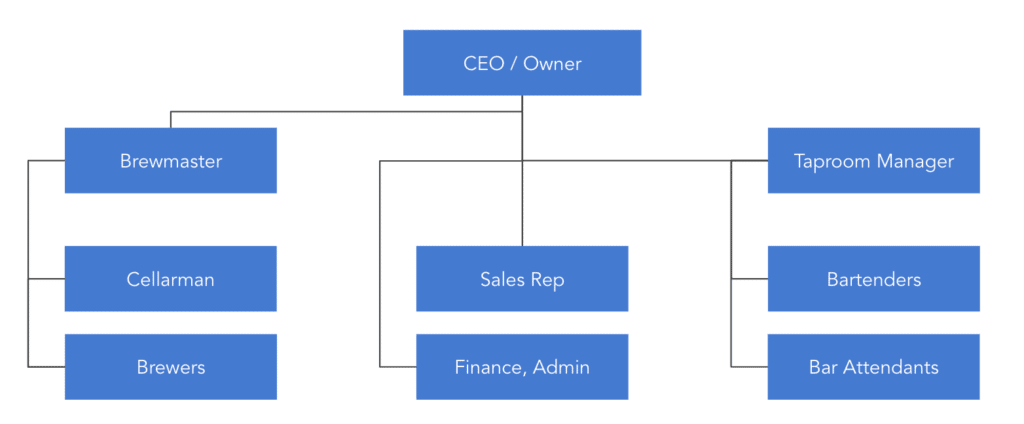
6. Financial Plan
The financial plan is perhaps, with the executive summary, the most important section of any business plan for a brewery.
Indeed, a solid financial plan tells lenders that your business is viable and can repay the loan you need from them. If you’re looking to raise equity from private investors, a solid financial plan will prove them your brewery is an attractive investment.
There should be 2 sections to your financial plan section:
- The startup costs of your project (if you plan to start a new brewery, purchase new equipment, renovate your brewery, add a taproom to your brewery, etc.)
- The 5-year financial projections
a) Startup Costs
Before we expand on 5-year financial projections in the following section, it’s always best practice to start with listing the startup costs of your project. For a brewery, startup costs are all the expenses you incur before you open your brewery and start making sales . These expenses typically are:
- The brewing systems and other equipment
- The leasing deposit for the space (if you rent) or to buy the real estate (if you buy)
Logically, brewery startup costs vary significantly based on factors like the size of your brewery, its capacity (in barrels), its location, the quality of equipment, etc.
On average, it costs $158,000 to $340,000 to start a 2,000 barrel craft brewery.
Note that these costs are for illustrative purposes and may not be fully relevant for your business. For more information on how much it costs to open and run a brewery, read our article here .
b) Financial Projections
In addition to startup costs, you will now need to build a solid 5-year financial model for your brewery.
Your financial projections should be built using a spreadsheet (e.g. Excel or Google Sheets) and presented in the form of tables and charts in the business plan of your brewery.
As usual, keep it concise here and save details (for example detailed financial statements, financial metrics, key assumptions used for the projections) for the appendix instead.
Your financial projections should answer at least the following questions:
- How much revenue do you expect to generate over the next 5 years?
- When do you expect to break even?
- How much cash will you burn until you get there?
- What’s the impact of a change in pricing (say 15%) on your margins?
- What is your average customer acquisition cost?
You should include here your 3 financial statements (income statement, balance sheet and cash flow statement). This means you must forecast:
- The number of barrels you produce over time ;
- The number of beers (or barrels) you sell ;
- Your expected revenue ;
- Operating costs to run the business ;
- Any other cash flow items (e.g. capex, debt repayment, etc.).
When projecting your revenue, make sure to sensitize pricing, cost of raw materials (malt, hops, packaging, etc.) and your sales volume. Indeed, a small change in these assumptions may have a significant impact on your revenues and profits.

7. Funding Ask
This is the last section of the business plan of your brewery. Now that we have explained what your brewery business model is, what types of beer you sell and to whom (individuals vs. businesses), what’s your marketing strategy, etc., this section must now answer the following questions:
- How much funding do you need?
- What financial instrument(s) do you need: is this equity or debt, or even a free-money public grant?
- How long will this funding last?
- Where else does the money come from? If you apply for a SBA loan for example, where does the other part of the investment come from (your own capital, private investors?)
If you raise debt:
- What percentage of the total funding the loan represents?
- What is the corresponding Debt Service Coverage Ratio ?
If you raise equity
- What percentage ownership are you selling as part of this funding round?
- What is the corresponding valuation of your business?
Use of Funds
Any brewery business plan should include a clear use of funds section. This is where you explain how the money will be spent.
Will you spend most of the loan / investment in paying your employees’ salaries? Or will it cover mostly the cost for the lease deposit and the renovation?
Those are very important questions you should be able to answer in the blink of an eye. Don’t worry, this should come straight from your financial projections. If you’ve built solid projections like in our Brewery financial model template , you won’t have any issues answering these questions.
For the use of funds, we also recommend using a pie chart like the one we have in our financial model template where we outline the main expenses categories as shown below.
Privacy Overview
Paid Through
You are using an outdated browser not supported by The Brewers Association. Please consider upgrading!
Business Plan Resources for Breweries

I started with the Brewers Association in 2014. My goal is to engage with as many members as possible, help them maximize their membership benefits, and act as the resident resource-Sherpa to assist in navigating through the mountain of information.
In my free time I like to sip on IPAs and pilsners while playing bass loudly or petting my dogs. I openly welcome pup-pictures and all heavy/loud/noisy music suggestions.
Many of the discussions we have at the Brewers Association (BA) revolve around resources and ideas that are specific to the beer industry. We focus on technical brewing, acquiring the right ingredients, building a brand, marketing beers, passing OSHA inspections, and complying with the TTB, among other things. Yet, there is a foundation to breweries, brewpubs, and taprooms alike, that is the common thread of all businesses. That foundation is a well-constructed business plan.
Learn How to Create and Maintain Your Business Plan
I’m often asked what business planning resources the BA provides, and I point members to our production statistics , benchmarking surveys , insight & analysis articles , and a myriad of Craft Brewers Conference (CBC) presentations covering specific business-related topics. Additionally, Brewers Publications offers The Brewers Association’s Guide to Starting Your Own Brewery , which includes guidelines for business planning and a sample business plan. Despite all this information, though, I still hear questions about the root of the business plan – where to start and how to create one. So, I’ve compiled a handful of resources to help breweries create and maintain a business plan.
We all have preferences on how we digest educational materials. So, the information below comes in multiple formats from a variety of sources. These resources are helpful whether you are looking to create your first business plan or simply want to update your current one. A business plan is a living document that should be updated regularly, rather than a ‘one and done’ springboard for prospective businesses. This is by no means a comprehensive list of resources on this topic, as there are hundreds of them available. Rather, it’s a jumping off point for members who want to establish and expand their knowledge. These resources can help us establish and refresh business plans, in addition to highlighting components we wish to explore further.
Business Plan Resources:
- Writing Your Brewery Business Plan is a step-by-step review of the necessary elements within a business plan and why those things are important.
- Successfully Planning, Starting and Operating a Nano Brewery offers a broad overview of the planning process with highlights on fundamental considerations for both launching and growing a brewery.
- The Nuts & Bolts of Great Business Plans – An often cited (and very comprehensive) guide to the broader and finer points of creating your business plan. This 30-page PDF document is updated yearly and provides excellent details on the what and why of each section in the outline.
- The U.S. Small Business Administration (SBA) is a great general resource for businesses. They offer a step-by-step tool that explains each section of the business plan template, along with a place to input your specific business information along the way.
- SCORE , a nonprofit resource partner with the SBA, has a variety of resources geared toward creating business plans and starting small businesses. This includes a 60-minute webinar on One Page Business Plans , an on-demand Developing a Business Plan course , articles about business plans , and even mentorship opportunities .
- For those who prefer educational videos, BizPlanTemplate.com offers a free business plan template paired with a 10-minute tutorial explaining each section.
- If learning on the go is of interest, scribendi.com offers a very succinct podcast outlining How to Write a Business Plan . For those starting from scratch, this is a good primer for the deeper dive into more detailed templates.
Don’t Forget to Use Your Community
As a final note, I’d be remiss not to mention the Brewers Association Forum . This is an excellent place to ask questions and engage with fellow brewery owners as you create and revise your business plans. While each brewery (and therefore business plan) will be unique, there is much to be learned from those around us. I am constantly reminded of the community mindset amongst many breweries, and this a fantastic way to connect and share resources with one another.
Resource Hub:
More like this.

The Human Resources Guide for Small Breweries

Zywave: Hiring and Onboarding
Resource hub, search brewersassociation.org.
- Brewers Association Search Form
Browse Resource Hub Categories
Explore the Brewers Association's most high-value resources and tools in one click. Need some additional guidance? Click here to setup a resource meeting with Graham, the BA's Engagement Coordinator.
Looks like you haven't bought a membership yet.
Finish setting up your membership at the link below!
Logging you in and unlocking this member exclusive.
Redirecting, your membership has expired..
Renew now to keep accessing exclusive seminars, industry statics, the BA forum, and much more!
Logging you in and unlocking exclusive member content.
There is a problem with your profile..
Please contact our membership team to evaluate your profile.

Item added to your cart
Here is a free business plan sample for a craft brewery.

If the idea of launching your own craft brewery has been fermenting in your mind but you're unsure of the first steps to take, you've tapped into the right resource.
In the following paragraphs, we will pour out a free sample business plan tailored for a craft brewery.
As any seasoned brewmaster or entrepreneur will tell you, a robust business plan is the backbone of a successful brewery. It serves as a roadmap, guiding you through the complexities of crafting your beer and your business.
To get your brewery's business plan brewing without any hiccups, you can fill out our craft brewery business plan template. Our connoisseurs are also on standby to review and refine it at no cost to you.

How to draft a great business plan for your craft brewery?
A good business plan for a craft brewery must capture the unique elements of the brewing industry and the passion behind the craft.
Initially, it's crucial to provide a comprehensive overview of the craft beer market. This includes current statistics and growth trends, which can be found in our craft brewery business plan template .
Your business plan should articulate your vision clearly, defining your target audience (such as craft beer enthusiasts, local patrons, or tourists) and your brewery's distinctive angle (specialty beers, local ingredients, sustainability practices, etc.).
Market analysis is a cornerstone of your plan. This means understanding the competitive landscape, recognizing the preferences of craft beer drinkers, and identifying potential niches or gaps in the market.
For a craft brewery, the product offering is paramount. Describe your range of beers - from IPAs and stouts to lagers and sours - and how they cater to the tastes and demands of your intended market.
The operational plan should detail the location of your brewery, the layout of the brewing and tasting areas, supply chains for hops, grains, and other ingredients, and the brewing process itself.
It's essential to emphasize the craftsmanship of your beer, the quality of your ingredients, and adherence to brewing standards and safety regulations.
Address your marketing and sales strategies next. How will you build a loyal customer base? Consider promotional tactics, community engagement, and direct sales strategies such as a taproom, tours, or merchandise.
Incorporating digital strategies, including a website and social media engagement, is vital for connecting with customers and building a brand in the digital age.
The financial section is critical. Outline your startup costs, sales projections, operating expenses, and the point at which you expect to break even.
Given that craft breweries often have high initial investment costs for equipment and materials, it's important to have a thorough understanding of your financials. For assistance, refer to our financial forecast for a craft brewery .
Compared to other business plans, a craft brewery's plan must pay special attention to licensing and regulations specific to alcohol production, distribution channels, and the potential for seasonal variations in sales.
A well-crafted business plan will not only help you to solidify your strategy and operations but also to attract investors or secure loans.
Lenders and investors are looking for detailed market research, realistic financial projections, and a clear operational plan for managing a brewery on a day-to-day basis.
By presenting a comprehensive and convincing business plan, you show your dedication to the craft and the viability of your brewery.
To streamline the process and focus on what you do best – brewing great beer – consider using our craft brewery business plan template .

A free example of business plan for a craft brewery
Here, we will provide a concise and illustrative example of a business plan for a specific project.
This example aims to provide an overview of the essential components of a business plan. It is important to note that this version is only a summary. As it stands, this business plan is not sufficiently developed to support a profitability strategy or convince a bank to provide financing.
To be effective, the business plan should be significantly more detailed, including up-to-date market data, more persuasive arguments, a thorough market study, a three-year action plan, as well as detailed financial tables such as a projected income statement, projected balance sheet, cash flow budget, and break-even analysis.
All these elements have been thoroughly included by our experts in the business plan template they have designed for a craft brewery .
Here, we will follow the same structure as in our business plan template.

Market Opportunity
Market data and figures.
The craft beer industry has seen a remarkable surge in popularity over the past decade.
Recent data suggests that the global craft beer market size is valued at billions of dollars and is projected to grow substantially in the coming years. This growth is driven by a rising consumer preference for artisanal and flavorful beers.
In the United States alone, there are over 8,000 craft breweries, contributing significantly to the economy with a combined annual revenue of tens of billions of dollars.
These statistics underscore the vibrant culture of craft brewing in America and its substantial economic impact.
The craft beer industry is at the forefront of innovation, with several key trends shaping its future.
There is a growing interest in low-alcohol and non-alcoholic craft beers, catering to health-conscious consumers who seek to enjoy beer without the effects of alcohol.
Sustainability is another major trend, with breweries increasingly focusing on eco-friendly practices, such as using renewable energy, recycling water, and sourcing local ingredients.
Experimentation with new flavors and beer styles continues to be a hallmark of the craft beer scene, with brewers often incorporating local and exotic ingredients to create unique offerings.
Technology plays a role as well, with advancements in brewing equipment and techniques allowing for greater precision and consistency in beer production.
Moreover, the rise of craft beer tourism has led to an increase in brewery tours and beer festivals, which serve as significant attractions for both locals and visitors.
Finally, direct-to-consumer sales and online distribution have grown, particularly accelerated by the shift in consumer behavior due to the pandemic.
These trends highlight the dynamic nature of the craft beer industry and its ability to adapt to the evolving tastes and values of consumers.
Success Factors
Several factors contribute to the success of a craft brewery.
Foremost is the quality and uniqueness of the beer. Breweries that produce distinctive and flavorful beers can create a strong brand identity and loyal following.
Innovation in brewing techniques and exploring new beer styles can also set a brewery apart in a crowded market.
The location of the brewery can influence its success, with those situated in high-traffic areas or scenic locations often enjoying higher footfall.
Engaging customer service and a compelling story behind the brewery and its beers can enhance the consumer experience and foster a sense of community.
Efficient operations and cost management are critical for maintaining profitability, while commitment to sustainability can resonate with environmentally conscious consumers.
Ultimately, a craft brewery that stays attuned to industry trends and consumer preferences while maintaining a passion for the art of brewing is well-positioned for long-term success.
The Project
Project presentation.
Our craft brewery project is designed to cater to the burgeoning craft beer market, offering a diverse range of artisanal beers crafted with the finest ingredients and traditional brewing methods. Situated in a vibrant neighborhood known for its appreciation of unique and locally-produced beverages, our brewery will feature an array of beers, including IPAs, stouts, lagers, and seasonal specialties, all brewed on-site for maximum freshness and flavor.
We aim to create a memorable drinking experience by focusing on the quality, depth, and innovative character of our beers.
Our craft brewery is poised to become a beloved destination for beer aficionados and casual drinkers alike, contributing to the local culture and economy by providing a gathering place for community events and beer education.
Value Proposition
The value proposition of our craft brewery lies in our commitment to producing exceptional artisanal beers that stand out in a crowded market. We offer a unique combination of traditional brewing techniques, innovative flavors, and sustainable practices.
Our dedication to creating a diverse and rotating selection of beers ensures that customers will always find something new and exciting to taste, while our focus on community engagement and education about craft brewing processes provides an enriching experience beyond the glass.
We are dedicated to fostering a culture of appreciation for quality craft beer and aim to be a cornerstone of the community, where friends and families can come together to enjoy the fruits of our labor and passion for brewing.
Project Owner
The project owner is a seasoned brewmaster with a passion for the art and science of beer making.
With a background in microbrewery operations and a deep knowledge of brewing techniques, he is driven to establish a craft brewery that stands out for its commitment to quality, community, and sustainability.
Armed with a vision to create a space where the craft beer culture can thrive, he is dedicated to offering a range of distinctive beers that cater to both connoisseurs and newcomers to the craft beer scene.
His dedication to the craft and his desire to share the joy of artisanal beer with others make him the ideal leader for this project, aiming to elevate the craft beer experience within the local community and beyond.
The Market Study
Market segments.
The market segments for this craft brewery are diverse and multifaceted.
Firstly, there are craft beer enthusiasts who are passionate about unique, locally brewed beers with distinct flavors and brewing methods.
Another segment includes young adults who are drawn to the social and cultural aspects associated with craft beer, such as brewery tours and tasting events.
There is also a growing segment of consumers interested in specialty beers, such as organic, sustainable, or limited-edition brews that offer a unique drinking experience.
Lastly, the market includes casual social drinkers who enjoy trying new and different beer options as an alternative to mainstream brands.
SWOT Analysis
A SWOT analysis of the craft brewery project highlights several key factors.
Strengths include a strong brand identity, innovative brewing techniques, and a commitment to quality and craftsmanship.
Weaknesses might involve the high initial investment for equipment and facilities, as well as the challenge of establishing a presence in a market with established competitors.
Opportunities can be found in the growing interest in craft beers, the potential for creating a loyal customer base, and the ability to capitalize on local tourism.
Threats include the volatility of raw material prices, particularly hops and barley, and the legal and regulatory challenges inherent in the alcohol industry.
Competitor Analysis
Competitor analysis in the craft brewery industry indicates a vibrant and competitive landscape.
Direct competitors include other local and regional craft breweries, as well as larger national craft beer brands.
These competitors vie for market share by offering a wide range of beer styles and engaging in community events and marketing initiatives.
Potential competitive advantages for our brewery could be a focus on sustainability, unique beer offerings, strong branding, and community engagement.
Understanding the strengths and weaknesses of these competitors is crucial for carving out a niche in the market and attracting a dedicated following.
Competitive Advantages
Our craft brewery's competitive advantages lie in our dedication to creating a unique beer-tasting experience.
We offer an array of distinctive and innovative beers, crafted with the finest ingredients and a commitment to flavor and quality.
Our brewery is not just a place to enjoy great beer; it's a destination where customers can learn about the brewing process, meet the brewers, and engage with the craft beer community.
We also emphasize sustainability in our brewing operations, which resonates with environmentally conscious consumers.
Our brand's story and connection to local heritage further differentiate us from competitors and foster a strong, loyal customer base.
You can also read our articles about: - how to open a craft brewery: a complete guide - the customer segments of a craft brewery - the competition study for a craft brewery
The Strategy
Development plan.
Our three-year development plan for the craft brewery is designed to capture the essence of artisanal brewing.
In the first year, we will concentrate on building a strong local following by offering unique, high-quality craft beers and engaging with the community through events and tastings.
The second year will focus on expanding our distribution to regional bars, restaurants, and retailers, as well as increasing our production capacity to meet growing demand.
In the third year, we plan to introduce new and seasonal beer varieties, collaborate with other craft breweries for limited edition brews, and potentially begin the exploration of international markets.
Throughout this period, we will remain dedicated to the art of brewing, ensuring that each batch meets our high standards of excellence and reflects our passion for innovative flavors.
Business Model Canvas
The Business Model Canvas for our craft brewery targets beer enthusiasts, connoisseurs, and those seeking a premium alternative to mass-produced beers.
Our value proposition lies in the uniqueness and quality of our craft beers, coupled with a commitment to sustainable brewing practices.
We will sell our products through our brewery's taproom, local distribution channels, and online platforms, utilizing our key resources such as our brewing equipment and industry expertise.
Key activities include brewing, marketing, and community engagement.
Our revenue streams will be generated from the sale of craft beers, merchandise, and hosting brewery tours and events, while our costs will be primarily associated with ingredients, production, and distribution.
Find a complete and editable real Business Model Canvas in our business plan template .
Marketing Strategy
Our marketing strategy is centered around creating a strong brand identity and fostering a sense of community.
We aim to engage with our customers by sharing the story behind our beers, the brewing process, and the inspiration for our flavors. Our approach includes hosting brewery events, offering tastings, and participating in local and regional beer festivals.
We will also build partnerships with local businesses and collaborate on special edition brews.
Additionally, we will leverage social media, influencer partnerships, and targeted advertising to reach a wider audience and promote our brand's ethos of quality and craftsmanship.
Risk Policy
The risk policy for our craft brewery focuses on mitigating risks associated with the brewing industry, such as supply chain disruptions, changes in consumer preferences, and regulatory compliance.
We will ensure a consistent supply of high-quality ingredients by fostering strong relationships with suppliers and maintaining a diversified inventory.
Regular product testing and adherence to brewing best practices will help us maintain product quality and safety.
Prudent financial management and market analysis will guide our growth strategy to avoid overextension. We will also secure comprehensive insurance to protect against business-related risks.
Our priority is to deliver exceptional craft beers while safeguarding the sustainability and reputation of our brewery.
Why Our Project is Viable
We are passionate about launching a craft brewery that stands out for its creativity, quality, and community involvement.
With a growing market for craft beers and an appreciation for local, artisanal products, we believe our brewery has the potential to thrive.
We are committed to adapting to market trends and customer feedback, ensuring that our brewery remains a beloved destination for beer lovers.
We are eager to contribute to the vibrant craft beer culture and look forward to the successful journey of our craft brewery.
You can also read our articles about: - the Business Model Canvas of a craft brewery - the marketing strategy for a craft brewery
The Financial Plan
Of course, the text presented below is far from sufficient to serve as a solid and credible financial analysis for a bank or potential investor. They expect specific numbers, financial statements, and charts demonstrating the profitability of your project.
All these elements are available in our business plan template for a craft brewery and our financial plan for a craft brewery .
Initial expenses for our craft brewery include the cost of brewing equipment, fitting out the brewing and tasting areas to meet health and safety regulations, purchasing high-quality brewing ingredients, obtaining the necessary licenses and permits, and investing in staff training for brewing and customer service excellence. Additional costs will be incurred for branding, as well as initiating marketing campaigns to introduce our craft beer to the market.
Our revenue assumptions are based on a thorough market analysis of the local and regional demand for craft beer, taking into account the increasing popularity of artisanal and locally produced beverages.
We expect sales to grow steadily as we establish our brand in the craft beer community and gain recognition for our unique beer offerings.
The projected income statement outlines expected revenues from the sale of our craft beers, production costs (ingredients, labor, utilities), and operating expenses (facility lease, marketing, salaries, etc.).
This leads to a forecasted net profit that is essential for assessing the long-term profitability of our craft brewery.
The projected balance sheet will display assets such as brewing equipment, ingredient stock, and any property we own, against liabilities including loans and accounts payable.
It will provide a snapshot of the financial condition of our craft brewery at the end of each fiscal period.
Our projected cash flow statement will detail all cash inflows from sales and outflows for expenses, giving us a clear picture of our financial position and helping us manage our cash to prevent liquidity issues.
The projected financing plan will outline the mix of equity, loans, and any other financing methods we intend to use to fund our startup costs.
We will keep a close eye on the working capital requirement for our craft brewery to ensure we have enough funds on hand to support day-to-day operations, such as ingredient purchases, inventory management, and payroll.
The break-even analysis will show the volume of sales we need to achieve to cover all of our costs, including initial investments, and begin generating a profit.
It will signal the point at which our brewery becomes financially sustainable.
Key performance indicators we will monitor include the gross margin on our craft beers, the current ratio to evaluate our ability to meet short-term obligations, and the return on investment to determine the efficiency of the capital we have invested in our brewery.
These metrics will be instrumental in assessing the financial health and success of our craft brewery.
If you want to know more about the financial analysis of this type of activity, please read our article about the financial plan for a craft brewery .
- Choosing a selection results in a full page refresh.
- Opens in a new window.
Upmetrics AI Assistant: Simplifying Business Planning through AI-Powered Insights. Learn How
Entrepreneurs & Small Business
Accelerators & Incubators
Business Consultants & Advisors
Educators & Business Schools
Students & Scholars
AI Business Plan Generator
Financial Forecasting
AI Assistance
Ai pitch deck generator
Strategic Planning
See How Upmetrics Works →
- Sample Plans
- WHY UPMETRICS?
Customers Success Stories
Business Plan Course
Small Business Tools
Strategic Canvas Templates
E-books, Guides & More
- Sample Business Plans
- Food, Beverage & Restaurant
Brewery Business Plan

Things to Consider Before Writing a Brewery Business Plan
Now you might want to get started as soon as possible. But before you start working on your business plan keep the following things in mind:
Decide on a menu and acquire resources
Though a lot depends on individual demands, having a certain set of items and proportions that work is important for a brewery business.
Moreover, it is also important to know what works best for the majority of your customers so you can have a handy set of ingredients.
Above all, you need to maintain a combination of quality and cost-effectiveness while acquiring ingredients for your brewery.
Stay up to date with your consumer’s preferences
The main purpose of a brewery is to provide a quality customer experience. What sets a brewery apart from a usual bar is the experience that comes with selecting your ideal flavors and proportions.
Hence, knowing what your customers want, things that influence their tastes, and what motivates them to change is essential for your business to succeed.
Know your competitors
Knowing what your competitors are doing is essential to do better than them. The brewery business is huge but it is also very competitive at the same time.
Hence, it is essential to stay a step ahead of your competitors for your business to thrive.
Write Your Business Plan
Reading sample business plans will give you a good idea of what you’re aiming for. It will also show you the different sections that entrepreneurs include and the language they use to write about themselves and their business plans.
We have created this brewery business plan template for you to get a good idea about how perfect a brewery business plan should look and what details you will need to include in your stunning business plan.
Then again it’s no surprise because the demand for unique and different things is growing irrespective of the business. And a brewery can offer just that for beers.
Brewery Business Plan Outline
This is the standard brewery business plan outline which will cover all important sections that you should include in your business plan.
- Mission Statement
- Vision Statement
- Products and Services
- Customer Focus
- Management Team
- Keys to Success
- 3 Year profit forecast
- Startup cost
- Industry Analysis
- Market Trends
- Market Needs
- Target Market
- SWOT Analysis
- Marketing Strategy
- Ongoing Customer Communications
- Pre-Opening Events
- Online Marketing
- Pricing Strategy
- Operation Functions
- Administrative Functions
- Important Assumptions
- Brake-even Analysis
- Profit Yearly
- Gross Margin Yearly
- Projected Cash Flow
- Projected Balance Sheet
- Business Ratios
After getting started with Upmetrics , you can copy this sample brewery business plan template into your business plan and modify the required information and download your brewery business plan pdf or doc file.
It’s the fastest and easiest way to start writing your business plan.
The Quickest Way to turn a Business Idea into a Business Plan
Fill-in-the-blanks and automatic financials make it easy.

Download a sample brewery business plan
Need help writing your business plan from scratch? Here you go; download our free brewery business plan pdf to start.
It’s a modern business plan template specifically designed for your brewery business. Use the example business plan as a guide for writing your own.
Related Posts
Wine Bar Business Plan
Liquor Store Business Plan
AI-Driven Business Plan Development
Business Plan Cover Page Design Tips
About the Author
Upmetrics Team
Upmetrics is the #1 business planning software that helps entrepreneurs and business owners create investment-ready business plans using AI. We regularly share business planning insights on our blog. Check out the Upmetrics blog for such interesting reads. Read more
Plan your business in the shortest time possible
No Risk – Cancel at Any Time – 15 Day Money Back Guarantee
Popular Templates

Create a great Business Plan with great price.
- 400+ Business plan templates & examples
- AI Assistance & step by step guidance
- 4.8 Star rating on Trustpilot
Streamline your business planning process with Upmetrics .

How To Write A Comprehensive Brewery Business Plan
Starting a successful brewery is a big dream for many. To achieve this dream, you need to start with a solid brewery business plan.
Your business plan includes everything you need to organize before opening your business, from your business goals and operations to your brewery name, beer menu, and everything in-between. Getting this plan right is one of the most important steps toward your business's success.
In this guide, we’ll outline everything craft breweries should include in their business plan template.
What is a Business Plan?
A business plan is a document that lays out your entire strategy for starting a brewery. This includes business objectives, operations, and how your brewery will be profitable and viable. A business plan is a roadmap you follow when setting up your new venture.
Your business plan must include details of how you will set up your brewery and what you aim to achieve. Doing this helps you prepare for the new challenge and know what to expect throughout the entrepreneurship journey.
Why Do You Need a Brewery Business Plan?
Your business plan ensures you open up your brewery as smoothly and efficiently as possible. It helps you avoid surprises along the way, getting your establishment off the ground by following all the proper steps. A well-thought-out plan will boost the chances of your brewery’s success in a big way.
A brewery business plan is also necessary if you need to secure funding. Nobody will put money behind a new venture without a clear plan on how it will operate and what kind of revenue and profits are projected.

What to Include in Your Brewery Business Plan
There’s a lot to consider when you write a brewery business plan. To help you out, here are some of the essential features to include in this document:
Business Description Section
Start with an executive summary of your business. This should be a description with the basic outline of what your brewery business will look like, what it will do, and why it exists. The executive summary should include details like your brewery name, its purpose for being, and why you want to start it.
Also include the type of brewery you plan to start and the proposed size. Do you imagine a lively beer hall, a country brewery, a trendy gastropub? A clear concept and vision to work toward are essential. You should also include goals that you want to achieve.
The craft brewery industry is highly competitive, so it’s vital that your brewery stands out. Make sure to include your mission statement, what will make your brewery unique, and why this is important.
Business Operations Section
A vital part of the planning process is outlining exactly how your business will operate. When creating a plan for your craft brewery, try to detail exactly how the establishment will work - from sourcing ingredients to selling beer to customers.
Will you have a restaurant in your brewery? Will you sell beer to liquor stores, or will it only be available to consume on-site? If you do sell beer off premises, will you have sales reps? How far around the country do you plan to stock your beer? These are all important things to consider in your business model.

When you write a brewery business plan, include every detail of your operations. Think about transporting your beer, whether your brews will change over seasons, whether you will bottle or can your brews, and so on.
Management and Team Overview
A key part of your brewery business plan is outlining the people behind your business. You will need to have a plan for staffing and management requirements. Who will be in charge of which jobs? Having a clear management and staffing team structure will help you understand your brewery operations realistically.
You will certainly need a head brewer and a general manager. Depending on your business model, you might also need a chef/kitchen manager, a sales manager, and various support staff roles, such as assistant brewers, cooks, bartenders, and wait staff.
As a brewery owner, outline why you are the right fit for the job. Outline your brewery-related qualifications, experience, and interests. Repeat this for any other management positions that you have secured.
Menu Overview
If your brewery is going to be a success, it will need a great product. Carefully planned menus are vital parts of all breweries' business plans. Ideally, you should have already perfected your recipes and have some sample products and home brews available if you need to convince investors.
As a brewery, start with your beverage menu. Outline precisely what brews you will produce.
Will you have a flagship beer that your brewery is known for? Will you offer seasonal or limited-edition beers?

Make sure that the style of beers you brew makes sense to your location and target market. Having tried-and-tested recipes for your beers is essential. You will also need to know exactly what equipment you require for brewing all of your beers.
Then you will probably also need a food or snack menu. Some breweries are known for their food, while others serve light snacks to compliment their beers. Figure out a sample menu for your brewery and match it to your brewery concept. Will you do beer pairings? Will your brewery have a theme (like German or all-American BBQ)?
Again, testing this out and getting feedback on it is crucial. You will also need to make sure you understand the exact kitchen and equipment requirements for your menu.
You might be an amazing brewer with a killer business idea, but choosing the wrong location could be the downfall of your brewery. Location plays a massive role in the success of any brewery so try to be as specific about your location as possible in your microbrewery business plan. Take the time to carefully research different location options.
Ideally, you should open your brewery in an area with minimal competition and high demand. When choosing your business address, look for features like foot traffic, visibility, parking, and a great view. Some breweries are opened as “destination” breweries and could be in a remote or unique area that people want to travel to. Others do well in busy areas full of hungry and thirsty customers, like tourist destinations or shopping malls.

Of course, your brewery space will also need to be large enough to brew beer and seat customers or do tastings. However, some breweries have separate premises for brewing and serving the public.
Market Research
No business plan summary is complete without in-depth local market research. You need to understand your market and target customers. Use this to provide evidence of why your brewery idea will be viable. This should include an analysis of market trends, competitors, and customer segments.
Do some detailed competitive analysis of the area you plan to open your brewery. Understand who your main competitors will be and how your business will be different from them.
You will also need to understand the demand for a brewery. Asking locals and even sending out questionnaires can help here. You could also try to do a market or a “pop-up” brewery event in the area, partnering with another local business. This will help you understand demand and how people react to your craft beers.
Another central bit of market research is to create a detailed target customer persona. This should include your ideal clients' demographics, interests, income, age, and other relevant details.
Your competitive analysis section should also cover the general market price of craft beer and food in your area. When you conduct research, try to visit as many direct competitors as possible to understand how they operate, what they do well, and what you can do better.

A thorough market analysis will give you a good idea of the scale your brewery should operate at, who your potential customers are, and what new markets you could tap into.
Business Structure and Licenses
Outlining how your business will be structured is an integral part of any business plan. This needs to include who the business owners will be.
Some business structures include a sole proprietorship, a partnership, a limited liability company (LLC), and a corporation (C Corp). Choose the structure of your business based on how many people will be involved, how big the company will be, and how it will operate. The proper legal structure can have some significant personal and tax benefits.
When starting a brewery, include a plan for all of the licenses and legalities involved in the business. You will need permits for trading, selling food, and for brewing and selling beer. The specific requirements will differ between states. Contact your local government as early as you can to understand the specific legal requirements for your brewery.
Make sure to include the application process for these licenses in your timeline. You will also need to ensure these licenses, including a brewery license, are possible based on your business location.
Equipment and Setup
There’s a lot that goes into a brewery. Part of your brewery business plan is figuring out all the necessary equipment. This should be related to your menu, your brewery size, location, and how you plan to operate.

When planning your brewing equipment, consider the volume of beer you need to brew and have a clear plan for how you will be able to sell this. Your brewing capacity needs to be just right in terms of your business demand. If your capacity is too large, it will result in wastage. If it is too small, your brewing process won’t be able to hit demand, and you will miss out on revenue.
Beyond your brewing equipment, you might need kitchen equipment, a bar, tables and chairs, booths, glasses, a POS system , a coffee machine… the list goes on. Try to list every piece of equipment required for starting your business - from your mash tun right down to your coasters. All of these items need to be planned and accounted for. Getting this accurate is necessary for understanding what our realistic startup costs will be.
This might be quite a stressful part of our business plan, but it’s one of the most important things for all startups and small businesses to get right. Your brewery business plan must include accurate startup costs, predicted income statements, and financial projections. Quite simply, you will need to establish:
- How much capital is required to get the brewery started
- How much it will cost to operate the brewery
- How much revenue you can realistically expect to make each month (and year) after starting the business
- How much profit you will be able to generate

It seems simple enough, but a lot goes into this. You will need a clear profit and loss statement, realistic cash flow statements, and a pricing strategy that will work.
You also need to consider your cash reserves (you might not make a profit for a few months) and your stock and inventory. There is also packaging, software tools (accounting software, POS software, restaurant management software , etc.), payroll, and production costs. Let’s not forget to consider loan repayments, insurance, and other ongoing expenses.
If you pitch to potential investors or want to secure bank loans, you will need your financial plan to be absolutely watertight. This is what determines how viable your business idea is.
How will you attract customers once your business is open? You will need a clear marketing strategy. This could include a strong web presence , social media marketing, special promotions, eye-catching signage, a well-placed chalkboard, collaborations with other businesses, and more.
When establishing your marketing plan, keep your target customers in mind. The channels and strategies that your marketing plan includes will need to align with their interests.
Following these steps to draw up your business plan template should cover all the necessary details. Just remember that your brewery business plan is a working document. Dedicate enough time to creating your plan, and constantly update and improve it as you learn more about the market and industry.
Plan to host private events at your brewery? Get in touch with Perfect Venue to learn more about our event management software designed for breweries, independent restaurants, and hospitality groups.
Have thoughts on the article? Feel free to email us at [email protected] - we'd love to hear it!

Brewery Business Plan Guide + Example

July 6, 2023
Adam Hoeksema
In this guide, we will navigate the process of creating a brewery business plan that reflects your vision and entices potential stakeholders. Rather than viewing it as a chore that your lender may have tasked you with, embrace the opportunity to lay a solid foundation for your brewery's future growth.
Together, we will cover the essential components that make up a comprehensive brewery business plan, empowering you to showcase your brewery, analyze the market landscape, strategize marketing and sales efforts, and develop realistic financial projections. Your potential lenders will want to make sure your brewery plans are realistic and within industry averages as well!
This guide includes the following:
What Should be Included in a Brewery Business Plan?
- Conducting Market Research for Your Brewery Business Plan
- Creating Financial Projections for Your Brewery Business Plan
Example Brewery Business Plan
Brewery business plan faqs.
With that in mind as the path forward, let’s dive in.
A brewery business plan should compellingly convey to investors and lenders why beer enthusiasts and other customers would prefer your brewery over competitors, why you or your team are the optimum choice to manage the brewery, and how the financial projections are tailored to secure a favorable monetary return on their investment. Below is a detailed blueprint of our complimentary brewery business plan template .
Brewery Business Plan Outline
I. Executive Summary
II. Company Description
III. Market Analysis
IV. Marketing and Sales Strategy
V. Operations and Management
VI. Financial Plan
- Startup Costs and Use of Funds
- Annual Sales, Gross Profit and Net Profit
- Key Financial Ratios
- Financial Summary
- Income Statement Annual Summary
- Cash Flow Statement Annual Summary
- Balance Sheet Annual Summary
VII. Appendix
VII. Conclusion
How to do Market Research for a Brewery Business Plan
Market research forms the backbone of any brewery business plan. Understanding your position within the market and establishing that there is adequate demand for your brewery's unique concept, location, and price range is key. Learn more about our approach to brewery market research here. Essentially, your goal is to grasp your competition, gauge potential customer footfall, identify an optimal location, and anticipate any seasonal fluctuations that could affect your business. You can learn more about our Brewery market research approach here, and below are some useful tools and methods for conducting market research for your prospective brewery.
What Will be the Cost to Advertise my Brewery?
We recommend Google Keyword Planner to aid you in identifying the ideal keywords to promote and attract customers to your brewery's website. This tool also offers an estimate of the cost per click when advertising using different keywords, as shown below:

What Keywords are Customers Using in Their Searches?
We rely on both Google Keyword Planner and Ahrefs to discern which keywords are directing traffic to your competitors' websites. You can run a report on a competitor's website to uncover the keywords they are ranking for and the volume of organic traffic each keyword generates. This information can be pivotal in streamlining your SEO strategy.

How Seasonal are Brewery?
We utilize Google Trends to examine the seasonality of your brewery concept. For instance, it can highlight that "Craft Beer Breweries" might not have stark seasonal patterns, whereas a brewery with a specialty in summer ales might exhibit pronounced seasonal trends.

How Many Customers Do my Competitors Receive Each Month?
Lastly, it's advantageous to generate foot traffic reports for your competitors to gauge the typical number of patrons they serve at their breweries. An example is shown below that presents the number of visits per month for a specific location:

In the end, the projected customer base for your brewery is a key assumption that will be foundational to your financial projections. Therefore, understanding your competitors' patron volumes can assist in estimating the potential traffic to your brewery.
How to Create Financial Projections for a Brewery Business Plan
Now, it's time to translate your market research into meaningful financial projections. Unlike other industries, the art of brewing introduces unique variables that shape revenue projections. While some breweries face capacity constraints, dictated by factors such as available seating, others may be limited by their brewing capacity and the ability to efficiently fulfill orders. Creating accurate financial projections is crucial not only to showcase your brewery's potential to repay loans but also to demonstrate an attractive return on investment to potential stakeholders.
- Estimate startup costs for your restaurant
- Forecast revenue including distribution, tap rooms, brewpub
- Project food, beer, and labor costs
- Estimate your operating expenses like rent and utilities
- Calculate how much investor or loan capital you will need to open
If you use our brewery projection template , you'll be guided through this process, ensuring your projections adhere to the format required by investors or lenders. Typically, startup brewery projections should include an integrated income statement, balance sheet, and cash flow forecast to provide a comprehensive financial overview.
Through thoughtful financial planning and accurate projections, you'll not only showcase the potential profitability of your brewery but also gain the confidence of potential investors and lenders. Let our brewery projection templates assist you in presenting a robust financial plan that sets the stage for a successful brewing enterprise.
Discover our brewery business plan template , available in a customizable Google Doc format, allowing you to tailor it to your specific needs. Accompanied by our video walkthrough, you'll receive guidance on adapting the plan to your unique brewery concept.
Table of Contents
1. executive summary, 1.1. company overview.
Briefly introduce the company's background, products or services, and target market.
- Example: Barrel & Brew Co. is a boutique craft brewery located in Asheville, North Carolina. We are dedicated to producing exceptional handcrafted beers that showcase the artistry of brewing and embody the spirit of the local community.
1.2. Objectives
Outlines the company's short-term and long-term goals.
- Example: Establish Barrel & Brew Co. as a premier destination for craft beer enthusiasts in Asheville, achieving a 70% taproom occupancy rate within the first year.
- Example: Long-term: Plan to expand our operations, opening additional taprooms in neighboring cities and maintaining strong customer satisfaction..
1.3. Mission Statement
Describes the company's purpose and core values.
- Example: At Barrel & Brew Co., our mission is to create exceptional craft beers that captivate the senses and foster a sense of community. We are dedicated to promoting the art of brewing, supporting local farmers and artisans, and providing an inviting and educational space where beer enthusiasts can gather, share experiences, and appreciate the craftsmanship behind our beers.
1.4. Keys to Success
Highlights the factors that will contribute to the company's growth and success.
- Example: Barrel & Brew Co. thrives on the following key factors for success. We prioritize exceptional craftsmanship, ensuring our craft beers deliver unmatched quality and flavor. Our engaging taproom experience immerses beer enthusiasts through guided tours, tastings, and educational activities. Active community engagement through festivals, collaborations, and charitable support builds a loyal customer base.
2. Company Description
2.1. company history.
Provides context on the company's background and founding story.
- Example: Barrel & Brew Co. was founded by Martin Holts, a passionate brewer with extensive experience in the craft beer industry. Inspired by his love for brewing and the vibrant beer culture in Asheville, North Carolina, Martin set out to create a brewery that would celebrate the artistry and flavors of handcrafted beers.
2.2. Legal Structure
Describes the company's legal structure (e.g., sole proprietorship, partnership, LLC, corporation).
- Example: Barrel & Brew Co. operates as a limited liability company (LLC)
2.3. Unique Selling Proposition
Emphasizes the company's competitive advantage or unique offerings.
- Example: Barrel & Brew Co. distinguishes itself through its commitment to brewing excellence and innovation. We pride ourselves on crafting high-quality beers that showcase a harmonious blend of traditional brewing techniques and inventive flavors.
2.4. Target Market
Defines the company's ideal customer base.
- Example: Barrel & Brew Co. targets beer enthusiasts and craft beer connoisseurs in Asheville, North Carolina, and beyond. Our offerings appeal to individuals who appreciate the artistry, quality, and diverse range of flavors found in handcrafted beers.
3. Market Analysis
3.1. industry overview.
Presents a general overview of the industry, its trends, and growth potential.
- Example: The craft beer industry in Asheville, North Carolina, is thriving, driven by the city's vibrant beer culture, tourism, and a strong community of beer enthusiasts. With a growing demand for high-quality and diverse craft beers, the industry presents significant growth potential for Barrel & Brew Co.
3.2. Competitor Analysis
Evaluates the company's direct and indirect competitors, as well as their strengths and weaknesses.
- Example: Direct competitors: Mountain Brew – a local brewery located in Asheville, North Carolina, specializing in craft beers that celebrate the mountainous region.
- Example: Indirect competitors: The Hop House – a popular brewpub and restaurant in Asheville, North Carolina. While they brew their own beers on-site, they also offer a wide selection of craft beers from other local and regional breweries.
3.3. Target Market Analysis
Explores the company's target customers, demographics, preferences, and pain points.
- Example: Barrel & Brew Co.'s target market includes beer enthusiasts, craft beer connoisseurs, and locals and tourists who appreciate the unique beer scene in Asheville. The target demographic comprises individuals aged 21 and above who seek flavorful, high-quality beers and enjoy exploring different beer styles and flavors.
3.4. Market Opportunities
Identifies potential opportunities for the company to grow within the market.
- Example: There are several opportunities for Barrel & Brew Co. to thrive in the market. Firstly, by actively participating in local beer festivals, events, and collaborations with other breweries, Barrel & Brew Co. can increase brand visibility and attract new customers. Additionally, partnering with local restaurants and bars to showcase their beers can expand their reach and tap into new customer segments.
Key Point 1

- Example 1: Conduct a competitor analysis to understand the strengths and weaknesses of existing breweries in the area. (e.g., Identify key competitors' offerings, pricing, and customer reviews to determine potential gaps in the market)
- Example 2:Analyze local beer consumption trends and preferences through surveys and market research. (e.g., Discover that there is a high demand for craft beers with unique flavors and local ingredients in Asheville)
4. Marketing and Sales Strategy
4.1. product or service offerings: .
Describes the company's products or services in detail.
- Example: Barrel & Brew Co. offers a diverse range of handcrafted beers. Our lineup includes a variety of beer styles, from refreshing lagers to hop-forward IPAs and rich stouts. Each beer is meticulously brewed using high-quality ingredients and crafted to deliver exceptional flavor and aroma.
4.2. Pricing Strategy
Outlines the company's approach to pricing its products or services.
- Example: Barrel & Brew Co. employs a competitive pricing strategy that reflects the quality and craftsmanship of our beers while remaining accessible to our target market.
4.3. Sales Strategy
Explains how the company plans to generate sales and build
customer relationships.
- Example: To generate sales and build strong customer relationships, Barrel & Brew Co. focuses on creating memorable experiences for beer enthusiasts. Our taproom in Asheville, North Carolina, serves as a hub for beer tasting, socializing, and educational events. We prioritize customer engagement by offering guided brewery tours, hosting beer tasting sessions, and providing a welcoming and knowledgeable staff to enhance the overall brewery experience.
4.4. Distribution Channels
Describes the methods through which the company will deliver its products or services to customers.
- Example: Barrel & Brew Co. primarily distributes its beers through its taproom in Asheville. Customers can visit the taproom to enjoy our beers on-site, purchase cans or growlers to-go, and engage directly with our team.
4.5. Promotions and Advertising
Details the company's promotional efforts and advertising strategies.
- Example: To increase brand awareness and attract customers, Barrel & Brew Co. employs a multifaceted approach to promotions and advertising. We leverage social media platforms to showcase our beers, engage with our audience, and promote upcoming events. We also collaborate with local food vendors, musicians, and artists to host unique experiences and create cross-promotional opportunities.
Key Point 2

- Example 1: Organize a beer tasting event showcasing the brewery's signature brews to attract beer enthusiasts and build brand awareness. (e.g., Attract 300 attendees to the event, generating positive feedback and inquiries about future offerings). Attend local festivals, events, etc to offer beer tastings and sale discounted beers
- Example 2: Collaborate with local restaurants and bars to feature Barrel & Brew Co.'s beers on their menus, expanding the brewery's reach and attracting new customers. (e.g., Secure partnerships with three popular restaurants, resulting in increased sales and customer referrals)
- Example 3: pre-sale “beer of the month” or mugs for a “mug club” to provide a discount for the first year (or lifetime) based on a pre-launch subscription fee
- Example 4: Social Media & Email signups. Build a local (and broader) following by documenting/sharing the process of brewing, building, launching the brewery. Collect emails to provide updates to local supporters
5. Operations and Management
5.1. brewery production.
Involves the brewing process, quality control, and packaging of the beers.
- Example: Barrel & Brew Co. focuses on producing high-quality beers by adhering to strict brewing standards, conducting regular quality checks, and implementing efficient packaging and labeling processes.
5.2. Inventory Management
Refers to the management of raw materials, brewing supplies, and finished beer inventory.
- Example: Barrel & Brew Co. maintains a comprehensive inventory management system to monitor stock levels, track ingredient usage, and ensure sufficient supply of brewing materials. This enables us to meet customer demand and optimize production efficiency.
5.3. Taproom Operations
Encompasses the management of the taproom, including customer service, beer pouring, and creating a welcoming atmosphere.
- Example: Barrel & Brew Co. places a strong emphasis on exceptional customer service and creating a warm and inviting environment in our taproom. Our well-trained staff provides knowledgeable guidance on beer selection, offers a memorable tasting experience, and fosters a sense of community among our patrons.
5.4. Compliance and Regulatory Requirements
Involves adhering to local, state, and federal regulations related to brewing, licensing, health and safety, and responsible alcohol service.
- Example: Barrel & Brew Co. ensures compliance with all applicable laws and regulations governing the brewing industry. We maintain proper licensing, prioritize health and safety protocols, and promote responsible alcohol service to uphold the highest standards of legal and ethical practices.
Key Point 3

- Example: Martin Holts, the owner of Barrel & Brew Co., has a decade of experience in craft beer brewing, including managing a successful brewery in a different location. His expertise ensures a deep understanding of brewing techniques, quality control, and industry trends.
- Example: The brewery's head brewer, Sarah Thompson, is a renowned expert in the craft beer industry, having won multiple awards for her innovative beer creations. Her expertise brings credibility and a competitive edge to Barrel & Brew Co.
5.5 Staffing and Human Resources
Covers the recruitment, training, and management of a skilled and dedicated team.
-Example: Barrel & Brew Co. places great importance on hiring passionate and knowledgeable individuals who share our commitment to brewing excellence. We provide comprehensive training programs, offer competitive compensation, and foster a positive work environment to attract and retain top talent in the industry.
5.6. Financial Management
Involves budgeting, accounting, and financial analysis to ensure the brewery's financial stability and profitability.
- Example: Barrel & Brew Co. maintains a robust financial management system, which includes accurate bookkeeping, regular financial analysis, and strategic budgeting. This allows us to make informed business decisions, manage expenses effectively, and pursue growth opportunities while maintaining financial sustainability.
All of the unique Brewery financial projections you see here were generated using ProjectionHub’s Brewery Financial Projection Template . Use PH20BP to enjoy a 20% discount on the template.
6. Financial Plan
6.1. startup costs.
Provide a detailed breakdown of the total startup costs requirements, and where you plan for those funds to come from. You will also want to breakdown how the startup costs will be used including working capital to cover losses before the business breaks even.
- Example: Creating a solid financial plan is crucial, and we are taking the necessary steps to ensure the success of Barrel & Brew Co. We have raised $150,000 through personal investment from Matin, and we are working with financial institutions to secure a business loan of around $500,000. By combining these funding sources, we are confident in our ability to meet the startup cost requirements and establish a strong foundation for Barrel & Brew Co.

6.2. Revenue Projections
Provides an estimate of the company's future revenue based on market research and assumptions.
- Example: Barrel & Brew Co. projects $1,367,824 in revenue in the first year. The company anticipates steady growth in revenue over the initial five-year period.

6.3. Expense Projections
Estimates the company's future expenses, including fixed and variable costs.
- Example: Barrel & Brew Co.'s expenses include property lease, accounting, advertising, professional services, utilities, and more.

6.4. Profit and Loss Statement
Summarizes the company's revenue, expenses, and net income over a specific period.
- Example: Barrel & Brew Co. expects to achieve profitability within the first two years of operation.

6.5. Cash Flow Projections
Outlines the company's projected cash inflows and outflows.
- Example: Barrel & Brew Co. cash flow projections account for seasonal fluctuations in sales and expenses.

6.6. Break-even Analysis
Determines the point at which the company's revenue equals its expenses.
- Example: Barrel & Brew Co. anticipates reaching its break-even point in year 2 of operation.

Watch how to create financial projections for your Brewery

Key Point 4

- Example 1: Compare financial projections with industry benchmarks for breweries of a similar size and production capacity. (e.g., Aim for a gross margin of 50%, which is within the typical range for craft breweries)
- Example 2: Consider potential market growth and expansion opportunities in Asheville, factoring in expected revenue increases from increased distribution and taproom sales.
7. Appendix
7.1. supporting documents.
Includes any relevant documentation that supports the information presented in the business plan, such as resumes, financial projections, market research data, and permits or licenses.
7.2. Glossary of Term
Provides definitions for industry-specific terms used throughout the business plan to ensure reader comprehension.
7.3. References and Resources
Lists any sources or resources referenced during the preparation of the business plan, including industry reports, market research data, and relevant publications.
Key Point 5

- Example: Martin Holts and his family invest a substantial amount of personal funds into the brewery's startup costs, demonstrating their commitment to the business's success.
- Example: The brewery secures a small business loan backed by the collateral of brewing equipment, showing the willingness to assume financial risk and ensuring the lender's confidence in the venture.
How can I choose the ideal location for my brewery?
When selecting a location for your brewery, consider factors such as the availability of water supply, access to quality ingredients, proximity to your target market, zoning regulations for breweries, space for brewing equipment and storage, and the potential for a taproom or retail area.
What are the steps to start a craft brewery?
Starting a craft brewery typically involves conducting market research, writing a business plan, securing funding, obtaining necessary permits and licenses, sourcing equipment and ingredients, hiring staff, and marketing your brewery.
How can I finance my brewery startup?
There are various options to finance a brewery startup, including self-funding, bank loans, crowdfunding, seeking investment from private investors or venture capitalists, or applying for government grants or incentives.
What permits and regulations do I need to comply with to operate a brewery?
The permits and regulations for operating a brewery can vary depending on your location. Typically, you will need permits related to alcohol production and distribution, licensing for on-site consumption or retail sales, compliance with health and safety regulations, and adherence to labeling and packaging requirements.
About the Author
Adam is the Co-founder of ProjectionHub which helps entrepreneurs create financial projections for potential investors, lenders and internal business planning. Since 2012, over 50,000 entrepreneurs from around the world have used ProjectionHub to help create financial projections.
Other Stories to Check out
How to finance a small business acquisition.
In this article we are going to walk through how to finance a small business acquisition and answer some key questions related to financing options.
How to Acquire a Business in 11 Steps
Many people don't realize that acquiring a business can be a great way to become a business owner if they prefer not to start one from scratch. But the acquisition process can be a little intimidating so here is a guide helping you through it!
How to Buy a Business with No Money Down
Learn the rare scenarios enabling the purchase of a business with no money down and delve into the complexities of selling via seller notes, highlighting the balance of expanded opportunities and inherent risks in these unique financial transactions.
Have some questions? Let us know and we'll be in touch.
Brewery Business Plan Template
Written by Dave Lavinsky
You’ve come to the right place to create your brewery business plan.
We have helped over 10,000 entrepreneurs and business owners create business plans and many have used them to start or grow their breweries.
Below is a brewery business plan example to help you write your brewery business plan:
Executive Summary
Business overview.
Mountain Craft Beer is a startup brewery located in Boulder, Colorado. The company is founded by Richard and Susan Williams, long-time craft beer enthusiasts who are ready to venture out and start their own brewing business. Richard has worked as a Brewmaster in a local brewery for over ten years. He has a Bachelor of Science degree in Food Science from the University of Colorado. Susan has a Masters degree in Business Administration from the University of New York. She has worked as a General Manager for a local restaurant and bar for the past five years. Now that the duo has obtained the experience and knowledge needed to run a craft beer business, Richard and Susan are ready to start a brewery of their own. Richard is confident in his ability to to manage the brewing process, while Susan is ready to take on the leadership role and manage all aspects of business operations. Richard and Susan will recruit a team of highly qualified professionals to help manage the day to day complexities of running a craft brewery – marketing and sales, accounting and budgeting, customer service, product management, and quality control.
Mountain Craft Beer will make unique craft beers that patrons can enjoy onsite or purchase through distributors. The Mountain Craft Beer brewery will provide a fun taproom tasting experience for guests to try out new brews. Mountain Craft Beer will be the ultimate choice in Boulder for its specialty craft beers made with premium locally sourced ingredients.
Product Offering
The following are the products and services that Mountain Craft Beer will provide:
- Craft beer tasting
- Barrel-aged beer
- Seasonal IPAs
- Seasonal Ales
- Branded merchandise and apparel
Customer Focus
Mountain Craft Beer will target all individuals over the age of 21 in Boulder, Colorado. They will target locals and tourists. They will also target all beer-drinkers from seasoned connoisseurs to individuals brand new to craft beer, and everyone in between. No matter the customer, Mountain Craft Beer will deliver the best customer service, unique product offerings, and craft beer tastings led by friendly, knowledgeable staff.
Management Team
Mountain Craft Beer will be owned and operated by Richard and Susan Williams, long-time craft beer enthusiasts who are ready to venture out and start their own brewing business. Richard has worked as a Brewmaster in a local brewery for over ten years. He has a Bachelor of Science degree in Food Science from the University of Colorado. Susan has a Masters degree in Business Administration from the University of New York. She has worked as a General Manager for a local restaurant and bar for the past five years. Now that the duo has obtained the experience and knowledge needed to open their own business, Richard and Susan are ready to start a craft brewery of their own. Richard is confident in his ability to to manage the craft brewing process, while Susan is ready to take on the leadership role and manage all aspects of business operations.
Success Factors
Mountain Craft Beer will be able to achieve success by offering the following competitive advantages:
- Friendly, knowledgeable, and highly qualified team of brewing professionals that will create unique flavors and blends, lead tasting experiences, and serve as informative guides providing the best customer service around.
- Unique product selection made with premium locally-sourced ingredients. New beers will be introduced each month and rotating seasonal selections will be renewed based on popularity.
- Mountain Craft Beer will be able to offer the best pricing in town because they will save on shipping costs by using local suppliers. The savings will be passed on to customers.
Financial Highlights
Mountain Craft Beer is seeking $500,000 in debt financing to launch its brewery business. The funding will be dedicated towards securing the facility and purchasing brewing equipment and supplies. Funding will also be dedicated towards three months of overhead costs to include payroll of the staff, rent, and marketing costs for the print ads and association memberships. The breakout of the funding is below:
- Build-out of the facility: $100,000
- Brewing equipment, supplies, and ingredients: $240,000
- Three months of overhead expenses (payroll, rent, utilities): $140,000
- Marketing costs: $10,000
- Working capital: $10,000
The following graph below outlines the pro forma financial projections for Mountain Craft Beer.
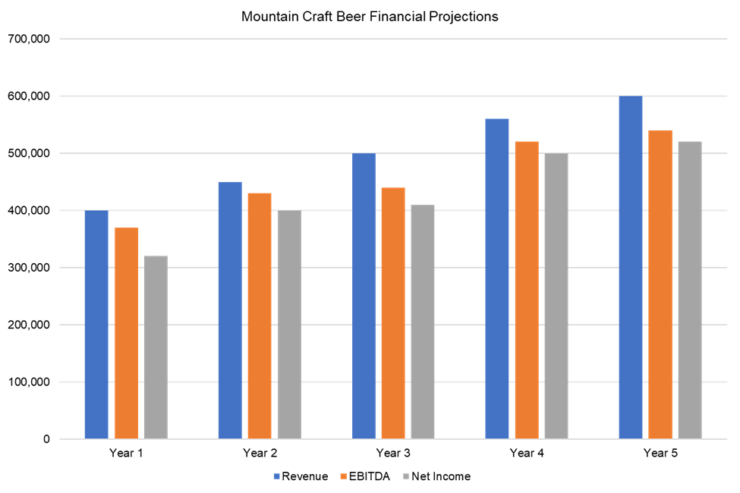
Company Overview
Who is mountain craft beer.
Mountain Craft Beer is a newly established craft brewing company in Boulder, Colorado. Mountain Craft Beer will be the ultimate choice for craft beer enthusiasts in the area. Mountain Craft Beer will provide an exclusive selection of craft beers, with new editions being introduced monthly and rotating seasonal selections that will be renewed based on popularity. Their exclusive, customer-centric approach combined with their use of locally sourced ingredients will make them a unique alternative to the typical craft beer experience. Mountain Craft Beer will be able to cater to their customers with unique product offerings and informative beer tasting events led by a team of highly qualified brewers. Mountain Craft Beer’s mission is to provide a fun and welcoming experience for its customers while delivering highly sought after creations that can’t be found anywhere else.
Mountain Craft Beer History
Mountain Craft Beer is owned and operated by Richard and Susan Williams, long-time craft beer enthusiasts who are ready to venture out and start their own brewing business. Richard has worked as a Brewmaster in a local brewery for over ten years. He has a Bachelor of Science degree in Food Science from the University of Colorado. Susan has a Masters degree in Business Administration from the University of New York. She has worked as a General Manager for a local restaurant and bar for the past five years.
Since incorporation, Mountain Craft Beer has achieved the following milestones:
- Registered Mountain Craft Beer, LLC to transact business in the state of Colorado.
- Has a contract in place to lease the brewing facility.
- Reached out to numerous contacts to include craft beer enthusiasts, former customers, and friends and family networks to create excitement for the new brewery.
- Began recruiting a staff of brewers, sales associates, and marketing professionals to work at Mountain Craft Beer.
Mountain Craft Beer Services
Industry analysis.
The global craft beer industry is valued at $95BM. Beer is known for being the oldest and most broadly consumed beverage in the alcoholic category worldwide. The craft beer segment of the retail beer market in the United States has been growing steadily over the past ten years. In 2012, craft beer accounted for approximately 10% of the market. By 2021, this number increased to 26.8% of the market.
The U.S. brewery industry first became popular in the 2000s and hasn’t stopped growing since then. In 2006, there were approximately 1,400 breweries across the country. As of 2020, this number has grown to over 9,000.
The primary driver for growth in the United States craft beer market is the public’s increasing desire to find new and innovative drinks. The three most popular types of craft beers are pilsner, ale, and lager. Lager is the most popular of the three. Craft brewery industry operators can maintain a competitive advantage in the market by producing unique flavors and catering to their customers’ tastes.
Customer Analysis
Demographic profile of target market.
The precise demographics for Boulder, Colorado are:
Customer Segmentation
Mountain Craft Beer will primarily target the following customer profiles:
- Residents 21 and over of Boulder, Colorado and surrounding areas
- Tourists 21 and over of Boulder, Colorado and surrounding areas
- Craft beer connoisseurs and enthusiasts (21 and over)
- Craft beer newbies (21 and over)
Competitive Analysis
Direct and indirect competitors.
Mountain Craft Beer will face competition from other companies with similar business profiles. A description of each competitor company is below.
Boulder Brewery
Boulder Brewery is a newly established craft beer brewery and gastropub located in Boulder, Colorado. Boulder Brewery is owned and operated by a team of professional brewmasters and chefs. The brewery offers onsite craft beer tastings and has a full restaurant open seven days per week. Boulder Brewery also sells its craft beer to distributors. The brewery promises to provide unique flavor blends and premium exotic ingredients.
BC Craft Beer Company
BC Craft Beer Company is a Colorado-based brewery that provides fresh craft beer blends. BC Craft Beer Company provides a comprehensive menu of ales, pilsners, lagers, and other beers on site and available to order online. The owners of BC Craft Beer Company are former brewmasters so they understand how to create fine craft beers from scratch. Customers can depend on their unique brewing process to achieve one-of-a-kind drinks. By choosing BC Craft Beer Company customers know they are getting the highest quality ingredients and specialty beverages they can brag about. BC Craft Beer Company uses holistic inspections and quality control measures to ensure each batch exceeds the most stringent quality standards.
Crafty Colorado Brews
Crafty Colorado Brews is a trusted Colorado brewery that provides superior service to patrons in Boulder, Colorado and the surrounding areas. The company makes small batches of seasonal drinks onsite. Products include pale ales, pilsners, and lagers. Crafty Colorado Brews hosts craft beer tasting events onsite and also distributes its products to local restaurants and liquor stores.
Competitive Advantage
Mountain Craft Beer will be able to offer the following advantages over their competition:
- Friendly, knowledgeable, and highly qualified team of brewing professionals that is able to create high quality, unique flavors using locally sourced ingredients and cater to customers’ preferences.
- New flavors developed each month and rotating seasonal selections that are renewed based on popularity.
- Mountain Craft Beer offers the best pricing in town. Their pricing structure is the most cost effective compared to the competition.
Marketing Plan
Brand & value proposition.
Mountain Craft Beer will offer the unique value proposition to its clientele:
- Highly-qualified team of skilled employees that is able to lead fun tasting events and provide insightful information to craft beer enthusiasts and novices alike.
- Unbeatable pricing to its customers – Using local suppliers allows the company to save on shipping costs and pass these savings on to its customers.
Promotions Strategy
The promotions strategy for Mountain Craft Beer is as follows:
Word of Mouth/Referrals
Richard and Susan Williams have built up an extensive network of craft beer enthusiasts and industry professionals. They plan to leverage this network to help them promote the new brewery.
Professional Associations and Networking
Mountain Craft Beer will become a member of Colorado Brewers Guild, Brewers Association, and the Master Brewers Association of the Americas. They will focus their networking efforts on expanding their customer network.
Print Advertising
Mountain Craft Beer will invest in professionally designed print ads to display in programs or flyers at industry networking events, magazines, direct mailers, and newspapers.
Website/SEO Marketing
Mountain Craft Beer will utilize an in-house marketing director to design the company website. The website will be well organized, informative, and list all of Mountain Craft Beer’s current product offerings. The website will also list contact information and upcoming tasting events.
The marketing director will also manage Mountain Craft Beer’s website presence with SEO marketing tactics so that anytime someone types in the Google or Bing search engine “Colorado craft beer” or “brewery near me”, Mountain Craft Beer will be listed at the top of the search results.
Social Media/Influencers
The marketing director will create a brand presence across multiple social media platforms such as Facebook, Instagram, Twitter, and TikTok. These accounts will be updated regularly to maintain an active social media presence. The company will work with social media influencers who will help to promote its products.
The pricing of Mountain Craft Beer will be moderate and slightly lower than competitors so customers feel they receive value when purchasing craft beer from the company.
Operations Plan
The following will be the operations plan for Mountain Craft Beer.
Operation Functions:
- Richard Williams – Co-owner and Brewmaster who will oversee all brewing staff and manage the product development process.
- Susan Williams – Co-Owner and Operations Manager who will oversee all staff (outside of brewers) including sales, marketing, accounting, and maintenance employees.
- Ben Smith – Staff Accountant will provide all client accounting, tax payments, and monthly financial reporting.
- Michelle Miller – Marketing Director who will provide all marketing promotions for Mountain Craft Beer.
- John Davis – Maintenance Director who will provide all maintenance for the facility.
Milestones:
Mountain Craft Beer will have the following milestones complete in the next six months.
8/1/2022 – Finalize contract to lease facility
8/15/2022 – Finalize personnel and staff employment contracts
9/1/2022 – Begin build-out of the brewery
9/15/2022 – Begin networking at industry events
9/22/2022 – Begin moving into the facility
10/1/2022 – Mountain Craft Beer opens its brewery for business
Financial Plan
Key revenue & costs.
The revenue drivers for Mountain Craft Beer are the fees charged to customers in exchange for the products and fees charged to enter exclusive tasting events.
The cost drivers will be the overhead costs required in order to staff a brewery. The expenses will be the payroll cost, rent, utilities, craft beer ingredients, and marketing materials.
Funding Requirements and Use of Funds
Key assumptions.
The following outlines the key assumptions required in order to achieve the revenue and cost numbers in the financials and in order to pay off the startup business loan.
- Number of Beers Sold Per Month: 3,000
- Average Fees per Month: $15,000
- Office Lease per Year: $100,000
Financial Projections
Income statement, balance sheet, cash flow statement, brewery business plan faqs, what is a brewery business plan.
A brewery business plan is a plan to start and/or grow your brewery business. Among other things, it outlines your business concept, identifies your target customers, presents your marketing plan and details your financial projections.
You can easily complete your brewery business plan using our Brewery Business Plan Template here .
What are the Main Types of Breweries?
There are a number of different kinds of breweries, some examples include: Microbrewery, Nano brewery, Brewpub, Taproom Brewery, Regional Brewery, and Contract Brewing Company.
How Do You Get Funding for Your Brewery Business Plan?
Breweries are often funded through small business loans. Personal savings, credit card financing and angel investors are also popular forms of funding.
This is true for a brewery business plan, microbrewery business plan, or a craft brewery business plan
What are the Steps To Start a Brewery Business?
Starting a brewery business can be an exciting endeavor. Having a clear roadmap of the steps to start a business will help you stay focused on your goals and get started faster.
1. Develop A Brewery Business Plan - The first step in starting a business is to create a detailed craft brewery business plan that outlines all aspects of the venture. This should include potential market size and target customers, the services or products you will offer, pricing strategies and a detailed financial forecast.
2. Choose Your Legal Structure - It's important to select an appropriate legal entity for your brewery business. This could be a limited liability company (LLC), corporation, partnership, or sole proprietorship. Each type has its own benefits and drawbacks so it’s important to do research and choose wisely so that your brewery business is in compliance with local laws.
3. Register Your Brewery Business - Once you have chosen a legal structure, the next step is to register your brewery business with the government or state where you’re operating from. This includes obtaining licenses and permits as required by federal, state, and local laws.
4. Identify Financing Options - It’s likely that you’ll need some capital to start your brewery business, so take some time to identify what financing options are available such as bank loans, investor funding, grants, or crowdfunding platforms.
5. Choose a Location - Whether you plan on operating out of a physical location or not, you should always have an idea of where you’ll be based should it become necessary in the future as well as what kind of space would be suitable for your operations.
6. Hire Employees - There are several ways to find qualified employees including job boards like LinkedIn or Indeed as well as hiring agencies if needed – depending on what type of employees you need it might also be more effective to reach out directly through networking events.
7. Acquire Necessary Brewery Equipment & Supplies - In order to start your brewery business, you'll need to purchase all of the necessary equipment and supplies to run a successful operation.
8. Market & Promote Your Business - Once you have all the necessary pieces in place, it’s time to start promoting and marketing your brewery business. This includes creating a website, utilizing social media platforms like Facebook or Twitter, and having an effective Search Engine Optimization (SEO) strategy. You should also consider traditional marketing techniques such as radio or print advertising.
Learn more about how to start a successful brewery business, brewery business planning and crafting a beer business plan :
- How to Start a Brewery Business
- How to Start a Brewery
Where Can I Get a Brewery Business Plan PDF?
You can download our free brewery business plan template PDF here . This is a sample brewery business plan template you can use in PDF format.
- Skip to primary navigation
- Skip to main content
- Skip to primary sidebar
- Skip to footer
Craft Brewing Business
Professional Insight, Unfiltered

Craft a brewing business plan: Tips from a brewery in planning
May 14, 2013 Chris Crowell
How do you turn a brewing passion into a brewing business? Craft brewers across the country mull that question over each day, with each brewer needing to address regional challenges and seek new strategies for seizing opportunities. What sets you apart? Will your production/revenue equation justify your company’s existence?
Take Spencer O’Bryan and Brennan Mann, for example. The two had homebrewed and studied brewing as a hobby for much of the last decade, but then became interested in bringing this beer passion to a wider audience in their local area. Their local area also happens to be Denver, one of the more competitive areas for craft brewing in the country. Launching a new craft brewing brand here would require some serious strategic planning, which led them to the fall 2012 NxLeveL for Start-Ups course at the Denver Metro Small Business Development Center (SBDC), which was a crash course in business plan writing.
“Right from the beginning, we knew we would need help in writing the business plan,” O’Bryan told Craft Brewing Business . “Not because we were incapable of piecing together the details or even formatting the plan properly, instead our goal was to use the classes to form a well thought-out plan in the quickest manner possible. We hoped that the classes would give us a good foundation for writing the business plan as well as expose details in the plan writing process that we otherwise would have overlooked. In addition, we used the class as a catalyst to get the business plan completed.”
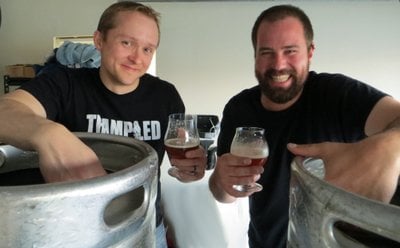
In working through the business details in the class in order to construct the business plan, O’Bryan and Mann understood the goals and focus of their brewing venture on a whole different level.
“It forced us to consider what we really wanted to accomplish by opening a brewery,” O’Bryan said. “We learned that at our core we are about quality, community and transparency.”
“The plan also helped us as a team,” Mann said. “More often than not, we brought ideas to the table individually and came away with more comprehensive, better-formed ideas in the end.”
After the class, the business plans were submitted into a competition, and the team’s plan finished second out of 29 entries in the Denver Metro Regional Business Plan Competition. From there, the business plan was submitted to the 2012 Leading Edge Statewide Business Plan Competition. Their plan finished second again, this time out of the statewide pool consisting of 35 business plans.
According to the judges, the plan was ranked second because of the amount of detail included in the plan. It showed a clear understanding of the elements that needed to be addressed, including their executive summary, product description, market and marketing strategy, management and operations. Their assumptions were realistic and reasonable. The financial piece was presented in good form and followed generally accepted accounting principles that were consistent with the rest of the plan. Overall, the plan was clear and concise.
“The plan serves two purposes at this point,” O’Bryan said. “The first being to help define our business moving forward and provide a reference for operations. We realize that plans have to be a living thing, as constant change and adaptation are critical to success. Secondly, the plan helps relay the base plan for the business and operations to investors and lenders.”
The plan behind the plan
Our concern is making great beer that we love, not making a buck. But in reality, unless you have an extremely detailed way to track and predict finances, you won’t be able to make great beer for very long. — Spencer O’Bryan As the judges noted, the business plan stood out because of the detail, details that also helped better form the conception of the brewery, specifically with the marketing and financing pieces.
The marketing portion of the plan, for example, focused not only on how the team plans to bring its new beers to the market and become established as a part of the community, it also gave detailed statistics on which neighborhoods would be ready for a craft brewery. The financial portion went to a similar level of detail. It included detailed cash flow projections, even down to the projected sales of individual beer styles based on current market trends.
“It also forced us to consider cycle time for fermenters and brewhouse time,” O’Bryan said. “This is most definitely a portion of the plan that will change the moment we start to brew and sell beer, but it gives us a great baseline from which to work. Our concern is making great beer that we love, not making a buck. But in reality, unless you have an extremely detailed way to track and predict finances, you won’t be able to make great beer for very long.”
Other details that the two mapped out in the plan included the look and feel of the taproom, examples of labels and tap handles and exactly what they’d plan to do to fulfill the “community involvement” aspect of their company creed.
“We had so many great ideas during our plan writing process, the plan became a way to catalog everything,” Mann said.
Brewers, brewers everywhere
Many aspiring businesses come to market in order to fill a perceived void or market inefficiency. The United States is a big place, and craft brewers are now dotting the landscape in an effort to be that area’s local brewer and potentially more. But what about a place like Denver, Colo., which is where Mann and O’Bryan plan to set up shop? To some it might seem oversaturated, but geography was another important focus of the business plan, as the two used research to prove their concept.
“Craft brewing in Colorado is most definitely a land of competition, but competition breeds excellence,” O’Bryan said. We realize the number of breweries that are out there already in Denver and the number of breweries in planning as well. Therefore, choosing a location, we feel, is critical to success. The plan also included a detailed spatial analysis of locations which included market analysis, population and proximity to other breweries. There are plenty of breweries that devote their efforts to a stylistic or regional niche. We prefer to remain agnostic when it comes to style and regional preference.
“We plan on providing a community-centric brewery that provides not only a stable menu of style selections but also a rotating tap selection that provides some extremely creative beer styles. Regardless of whether a beer is one of our staples, a seasonal ale, a session-able lager or a small batch experiment, it will be huge in flavor, big in body and emboldened to push the palette of true craft beer drinkers.”
The ethos of the company is to create world-class beer and not creating obscure beer for a novelty’s sake, according to O’Bryan.
“At the same time we are not interested in creating beer that appeals to the masses,” he continued. “We are interested in creating beer that makes us excited as craft beer drinkers and constantly reminds us of why we started brewing beer in the first place. Second only to the beer is our dedication to run a brewery that focuses on serving our community, striving to source the highest quality Colorado ingredients and with every passing year become a more sustainable operation.”
Top four business plan tips
O’Bryan and Mann recommended these four tips for other aspiring craft brewers out there as they try to tackle their own detailed business plan.
- Read, read, read. Read books, studies, surveys, articles and anything else you can get your hands on. And just because you finish the plan, don’t stop reading.
- Be prepared to be as detailed as possible with your plan . It helps to define hidden costs, expose holes in your ideas and force all parts of the plan to work in concert.
- Don’t be afraid to ask questions of brewers and breweries. You’d be surprised at what information and tips you can get.
- Research trademarks heavily if the name of your brewery is a critical component of your plan. We learned that lesson early on, thankfully.

The best laid plans…
Mann and O’Bryan are still searching for the right location for their brewery and actually are in the process of redeveloping the name because even the best laid plans will run into complications. Mann told us that they ran into a bit of trademark trouble with their original name, Halcyon Brewing.

“We were deeply disappointed when we learned from the trademark office that our application was rejected due to a likelihood of customer confusion with another brewery’s specific beer,” Mann said. “Due to this, we basically had to abandon everything we had worked on for the past year with respect to marketing. This really put us in a tailspin as to what we could do, as it seemed to us that literally every name we could think of was already swallowed up by a pre-existing brewery or winery.”
But as you’ve read, Mann and O’Bryan have done plenty of planning and research and did not get so far down the road in a hurry to launch that a brand rename would be a game-ender. Soon, the brewery formerly known as Halcyon will officially announce its new name and continue on its detailed path to opening a community craft brewery.
“Once we got our heads around this, it became apparent that we would need to develop something essentially bulletproof in effort to avoid the trademark issues so many breweries seem to be facing lately,” he continued. “With this in mind, we created a name that merged two words that describe our brewery: FERMÆNTRA. The moral of our story is, again, seriously research the hypothetical company name before you spend money on things like marketing materials and applications.”
This year, FERMÆNTRA hopes to open up with a 7-bbl system and produce about 300 bbls during its first year.

Reader Interactions
dannyogolo says
November 14, 2015 at 5:47 am
Im looking for someone to consult. we plan to open a craft brewery in Africa
May 16, 2013 at 3:45 pm
Craft a brewing business plan: Tips from a brewery in planning – Craft Brewing Business http://t.co/h8deujtv97
May 14, 2013 at 1:30 pm
RT @CraftBrewingBiz: Thanks to @Fermaentra for sharing its story for this feature on business plans and their role in starting a brewery. h…
May 14, 2013 at 1:20 pm
Thanks to @Fermaentra for sharing its story for this feature on business plans and their role in starting a brewery. http://t.co/tJFG7ASSC1
May 14, 2013 at 1:19 pm
RT @Fermaentra: Check out our interview with @CraftBrewingBiz We can’t thank them enough for giving us the chance to share our story http:…
May 14, 2013 at 1:05 pm
May 14, 2013 at 1:03 pm
May 14, 2013 at 1:01 pm
RT @CraftBrewingBiz: Craft a brewing business plan: Tips from a brewery in planning. #craftbeer http://t.co/cIvDnbQ98t
May 14, 2013 at 12:58 pm
May 14, 2013 at 12:57 pm
May 14, 2013 at 12:56 pm
Check out our interview with @CraftBrewingBiz We can’t thank them enough for giving us the chance to share our story http://t.co/hQOL8JymMr
May 14, 2013 at 12:50 pm
Check out our interview with @CraftBrewingBiz We can’t thank them enough for giving us the chance to share our story http://t.co/DxFSTi1QtD
[…] is a helpful article from our friends at Craft Brewing Business with more tips on writing you business plan. Also, the […]
[…] Craft a brewing business plan: Tips from a brewery in planning – How do you turn a brewing passion into a brewing business? Craft brewers across the country mull that question over each day, with each brewer needing to address … […]
[…] Craft Brewing Business ~ May 13, 2013 ~ Craft a brewing business plan: Tips from a brewery in planning […]
[…] https://www.craftbrewingbusiness.com/business-marketing/craft-a-brewing-business-plan-tips-from-a-bre… ; […]
[…] Craft a brewing business plan: Tips from a brewery in planning […]
Leave a Reply Cancel reply
You must be logged in to post a comment.
- Email Newsletter Sign Up
- About Craft Brewing Business
- Advertise on Craft Brewing Business
- Media Kit Download
- Privacy and Terms
House-Flipping Business Plan

Clothing Line Business Plan

Cannabis Business Plan

Laundromat Business Plan

- Business Plans
Brewery Business Plan
There is no question that there has been an increase in the number of craft breweries around the United States over the last several years. In 2018 alone, 1,049 new breweries opened while 219 closed their doors forever. With over 25.9 million barrels of craft beer sold in 2018, commanding over $27.6 billion in revenue, there’s no wonder that entrepreneurs are launching more breweries than ever. Unfortunately, setting up a brewery can be expensive. Often, entrepreneurs must seek the funds of investors to support the launch of their craft beer business. To meet and attract investors, they need a strong brewery business plan that supports their case and showcases the potential of their idea.
Writing a business plan for a brewery is a bit different than writing for other types of businesses. Even when compared to other food & drink venues, breweries have several unique factors that should be addressed as a strategy is devised.
In the following post, we will explain everything you need to know about creating an awesome investor-ready brewery business plan.
Download our winning brewery business plan template here!
The Brewery Business Plan Format
The layout for a brewery plan will typically follow that of a standard business plan. However, because of the unique nature of a brewery business, the approach to each section may be considerably different. Here are a few tips as you write through each section of your brewery business plan.
Executive Summary
Seed and pre-seed investors receive business plans constantly, and often, they don’t make it through the first few pages. The executive summary is probably the most critical part of your document. Essentially, this summary is the pitch that sells investors on reading the rest of the plan! With so many breweries launching, your executive summary must effectively explain what makes your brewery special. After reading your summary, investors should be able to clearly recognize what factors make your brewery unique and why consumers would choose to patronize your establishment over another. In general, your executive summary should sum up the major concepts that are explained throughout your plan. If delivered successfully, investors will be excited to continue reading your plan. *Tip* Although the executive summary is presented first in your brewery business plan, you should write it last. This way, you can ensure that it follows your strategy perfectly and that it mentions all notable details.
Brewery Details
This section introduces readers to your brewery concept and the products that it will offer. There are four major parts to a brewery details section: 1) Description: Explain how the brewery concept was conceived and the milestones that have been achieved to date. Milestones can include things such as finding a location, securing advisors, or establishing beneficial relationships. 2) Mission Statement: Write a statement that explains what your brewery stands for, who it serves, its beliefs towards quality craft beer production, and the type of experience you hope to provide to guests. 3) Products & Services: List out the different products and brands you serve. Explain what makes these products unique from competitive breweries. Whether your product is more flavorful or fresher, this is the section to describe why your product is special – if it is in fact special. Don’t just stop at the product itself, but also consider the type of unique experience that your customers can expect when frequenting your brewery. 4) Key Success Factors: This section describes the factors that must be accomplished in order for you to successfully launch and operate a brewery. Major key factors for brewery success include things like finding the right location, having the right brewing process, choosing the right equipment, and building a repeat customer base.
Market Research
Unfortunately, not every market is ripe for a brewery. In some markets, there just aren’t enough ideal consumers to keep a brewery at a meaningful capacity. It’s important to know who your customers are, how many of them exist within your specific region, and how many you can attract to your brewery each day, week, or month. Start your research by performing a target market analysis to estimate the size of your serviceable obtainable market. Unless you can find the research to prove that there is both a large market and a high demand for a brewery, investors will hesitate to invest their capital. Assess the demographics of your target consumer. Use research from reliable resources like the Census to accurately estimate how large your market really is.
Competitive Analysis
No matter how great your beer is, your brewery will face some level of competition. Even if you are the only brewery in town, competition will come from local bars, restaurants, and local stores that sell craft beer. On a secondary level, there will also be competition from distributors of mass-produced domestic and imported beers. Make sure you identify all of your players within your local competitive landscape. Assess what customers enjoy about these venues and what they dislike. Perform a SWOT analysis on your brewery business and detail the advantages you have over other breweries, bars, beer suppliers.
Marketing Strategy
Having the best brewery in town is meaningless if you can’t get customers through the door. Unfortunately, just existing isn’t enough – competition in the food & beverage industry is usually quite extreme and customers have many options to choose from. Decide how you will introduce your brewery to potential customers. Whether it’s local marketing with newspaper ads in a community newspaper or directory, or online using social media – an effective strategy must be implemented to succeed. Consider how you will market your brewery, how much you will invest into each method, and how many customers you will attract with your intended budget. Furthermore, answer the following questions:
- How will you ensure that customers are satisfied enough to give your brewery great ratings and reviews?
- How can you upsell to help increase the value of each customer on each visit?
- How can you ensure that customers will return to your brewery on an ongoing basis?
Operational Strategy
Planning a brewery is tough, but operating one is far more challenging. There are many factors that go into operating a brewery on an everyday basis. The operational strategy for your brewery plan should include the following elements:
- Location: Explain where your brewery will be located, how big the facility will be, why it is the perfect location, how you will renovate the location, and more.
- Quality Control: Maintaining product quality is essential for a brewery. Failure to stay on top of things could lead to food inspection violations. Detail the steps you will take to ensure that a high-quality standard is met at all times.
- Customer Service: Breweries are service-based businesses, too. Customer service is key to ensuring that visitors are satisfied enough to return in the future. Describe how you will deal with customer service and how you will handle any customer complaints.
- Sales Process: Explain the process of how a customer receives your product from the moment they walk into the door. Who seats them? Who serves them? How are they served? How is payment collected? What happens after they leave?
- Staffing: Lastly, explain your staffing plan. Consider each individual you will need to hire to operate your brewery properly. When will you hire them? How will you train them? How much will you pay them?
Financial Projections
Finally, investors want to see the financial viability and potential of your brewery. Prior industry research should help you minimize assumptions as you build your financial model. Once you have identified all major expenses (such as equipment and staffing), be sure to identify minor expenses, too (such as equipment maintenance, cleaning supplies for the bathroom, soap to wash dishes with, and etc.). Your financial model should be realistic and should replicate the strategies described in your brewery business plan. It should showcase realistic growth, and should be based on real data and statistics – not fluffed up with too many unproven assumptions.
Special Considerations

While the business plan format of a brewery plan may be similar to every other plan, there are several special considerations that must be made. There are some challenges that are exclusive to food & beverage businesses, and some that are exclusive to breweries specifically. Here are three special considerations you should make when writing your brewery plan.
Pay Attention to the Details
Breweries have only recently began to explode across the country. Investors will either be experienced with breweries and extremely familiar with the associated details, or they will be clueless about what it takes to run a brewery. Either way, it is important that you are able to consider and communicate each detail clearly. Interview brewery owners who are not competitors – such as those operating in other regions. Ask if they can share their experience and have them look over your financials to make sure you aren’t forgetting anything. When starting a brewery, research is everything – and sometimes, you won’t find all the answers through an online search. Build relationships within the industry and use those relationships to to your advantage as you plan your brewery.
Consider the Community
Knowing your customer is essential to establishment and growth. The most loyal customers will generally come from the surrounding community. The better you know the community, the more effective you will be in serving your customers. Look into other food & beverage businesses that have launched within the area. Pay special attention to the ones that didn’t succeed. What factors led to their success? Why did other bars and restaurants succeed instead? Interview potential customers within the community. Ask them what they like about current options and what they’d like to see in a new brewery. The feedback will not only help you develop a business that the community supports, but it will also help you validate your concept to investors.
Know Your Numbers
If there’s one thing you want to be extremely detailed about – it’s your numbers. Finding out that your strategy isn’t viable during the business planning process may sting, but finding it out post-launch can completely derail your business. Every financial model will have some level of assumption built into it. Having too many assumptions though will turn a brewery financial model into a pipedream. When you write your brewery business plan, research as deeply as you can to find out the real numbers associated with starting and running your business.
Need Help With Your Brewery Business Plan?
Writing a brewery business plan can be an extensive challenge for an entrepreneur. At ThinkLions, we have written dozens of business plans for breweries and other food & beverage businesses – and we know what it takes to get your brewery funded. Need help? Contact us today and let us help you write the best brewery business plan possible!

You may also like

Music App Business Plan

Bar Business Plan
Leave a reply cancel reply.
Your email address will not be published. Required fields are marked *
Save my name, email, and website in this browser for the next time I comment.
How to Start a Brewery: Growing Your Own Craft Beer Business
Anthony St. Clair
28 min. read
Updated March 18, 2024
Free Download: Sample Brewery Business Plan Template
In 2018, there were more than 7,450 breweries in the U.S.—well over than the historic high of 4,131 breweries in 1873, according to the Brewers Association . In such a crowded market, making good beer and opening the doors isn’t enough anymore.
But, the good news is, if all those people could start a brewery, then you can too—as long as you know what you’re getting into and have a solid business plan for your brewery.
From running coolant pipes to navigating regulations, starting a brewery is a messy, convoluted job full of twists, turns, delays, setbacks, and surprises—but it’s also one heck of a ride.
In this guide to starting a brewery, we’re going to talk with brewers who’ve been-there-done-that, and we’ll get insights from experts in supporting industries such as insurance and finance, as well as discuss regulatory issues.
While it may be your dream to brew great beer, this guide will help introduce you to the business side of craft beer.
This guide will cover the seven essential steps to starting a brewery:
- Planning a brewery
- Finding a brewery location
- Choosing brewery equipment
- Building relationships with vendors and the local community
- Funding a brewery
- Obtaining insurance before opening a brewery
- Keeping regulations in mind when starting a brewery
- Step 1: Planning a brewery
No matter its size or age, every brewery was once a startup.
ColdFire Brewing , a 10-barrel brewery, came online in December 2015, founded by Dan Hughes and his brother Stephen. They’re constantly hard at work on business development and recipe formulation, navigating bureaucracy, and enduring the inevitable delays that come with brewery construction, equipment delivery, and regulatory approval.
“We began to get serious about starting our brewery several years ago, and we were still working out details as we prepared to open our doors,” says Dan.
The Hughes brothers developed a solid business plan and built a core team to bring their vision to reality. Backed by a team of private local investors , ColdFire gained access to additional capital through an SBA loan .
While Dan heads up operations, his brother Stephen is head brewer, and their team also includes directors of finance and brand, respectively.
Brought to you by
Create a professional business plan
Using ai and step-by-step instructions.
Secure funding
Validate ideas
Build a strategy
Watch your finances
Having a key financial person in place has helped them get better at monitoring cash flow and their overall financial status and needs, says Dan. Most small businesses and startups that are looking to grow— hire a new employee , or buy a new piece of equipment, or open a new location —need to think hard about cash flow, or making sure they have enough money in the bank to meet payroll and other financial obligations.
Review your business plan regularly
Committing to regularly reviewing your business plan and financials is a good step toward making more informed, smarter spending decisions, that can have a big impact on a new business’s long term viability. Forcasting, and then comparing your actual results against your projections on a regular basis, will help you spot any issues before it’s too late to do something.
If you don’t have a business plan yet, don’t skip it
If you don’t have a business plan for your brewery just yet, don’t skip it. Planning is proven to help you grow 30 percent faster . Plus, if you’re going to seek a loan or investment, your funders will expect you to have one. If you’re not sure what you should include in your plan, check out brewery sample business plans on Bplans. You can download them for free to help you get started. Here are two of our most popular example plans:
Sedibeng Breweries
About the plan: Sedibeng Breweries is a medium-scale brewery located in the growing industrial center of Selebi Phikwe, Botswana. Initial plans are to produce three main lines of beer. These products will be distributed to remote yet extremely viable areas, where the market is appreciative of readily-available, good-quality brew.
Martin Cove Brewing Company
About the plan: Located in Medford, Oregon, Martin Cove Brewing Company has been a successful microbrewery for the past three years. This year, Martin Cove Brewing Company will gross $520,000 in sales. With this money, they plan to expand its distribution to selected metro areas within the state of Oregon. In addition, they will introduce a new product, a traditional German Marzen-style lager.
Dan Hughes’ advice on starting a brewery
1. the most important detail is defining a clear vision.
“We know what kind of brewery we want to create and we have tried to let that vision drive all of our decisions.”
2. There has to be a commitment to the craft
“We find this opportunity to open a brewery a privilege, and we certainly aren’t doing this for the money. In fact, we’re taking a significant pay cut to have the privilege to open a brewery. We do so with a vision toward creating a quality brewery that honors the traditions of those that have gone before us.”
3. Every relationship is important
“When you build a few good relationships, suddenly they open the door for more relationships, and that pattern has only continued to hold true.
“Our bank had heard of us before we ever met them, and our landlord had been approached by other breweries in the past. Fortunately, we have always found it important to treat people well and listen to good people who have good advice. That has ended up serving us well.”
4. Prepare for license and regulation challenges
“They take time—so much time—to file, follow through, and gain approval. Having been planning this for so long, we kind of knew what we were getting into and have thus far been able to get through most of these challenges to-date. But they all take so much time.
“With that said, the federal license, or TTB [Alcohol and Tobacco Tax and Trade Bureau] permit, was the longest and most arduous. The more complex the operating structure of a business , the more information and time required.”
- Step 2: Finding a brewery location
From land use to public taste, the location where you plan on opening a brewery is a crucial decision. Generally, brewers want to set up shop in their own backyard.
Here are some questions to consider:
- What are the relevant local and state laws affecting breweries? (And there will be plenty—brewing is one of the most regulated industries in the country.)
- Where in your area will you find land or a building with the right zoning, size, facilities, and access for bringing in raw materials, attracting customers, and/or shipping out finished beer for distribution?
- What local favorites will you need on tap to appeal to the market, and where can you innovate to stand out?
- Will you only brew ales, or will you also make space for lagers, a barrel-aging program, and so on?
- What type of brewery will you be: production brewery or brewpub?
- How wide do you want to grow production and distribution, or do you want to focus on selling over your own bar?
- Do you want to scale to multiple locations?
- What construction will be needed to get the doors open on your first location?
All these questions and more will influence the right space for your brewery. However, the main thing is to start with the right space—and one that will be bigger than what you think you will need, says Jason Jordan of Propel Insurance.
“I cannot tell you how many brewers I have talked to in year two to three in business,” he says, “and they all said their biggest regret was not getting a bigger space that they could grow into.”
However, brewers also need to be willing to take a hard look at where they want to locate and do their homework to make sure they can establish a successful brewery there. Word of mouth is no substitute for market research , says Ben Price, co-founder of Hard Knocks Brewing, a small brewpub in its second year of operation.
“The single biggest mistake I have made was locating my business in a town that could not care less about craft beer,” says Ben. He recommends brewers use data firms such as Insightics to see where and how people spend their money in an area.
“You’re looking for a number of 70 percent or more within five miles of the zip code you desire,” says Ben. “I made the mistake of trusting in word of mouth. You want locally oriented people, people who want a good product, made local.”
- Step 3: Choosing brewery equipment
Your initial system will likely be seven to 15 barrels, but run your own numbers. Figure out how much you’ll need to have in production at a time to be profitable.
What you need to know about buying new
A new system might be subject to delays, especially if demand from other breweries is high, but you’ll be able to design to your needs and specifications, and you’ll have support when issues arise (and they will).
“You’ll probably start with a seven-barrel system, spend anywhere between $130,000-$175,000 new,” says Patrick McCarthy, who works in the financial sector and aids breweries with capital and business planning.
Is it a good idea to buy used brewing equipment?
A used system might be through the door quicker and might save you money up front, but make sure you’ve thoroughly reviewed the system and seller—and remember that when you have problems, you’ll likely be on your own to fix them.
“Used systems are almost as expensive, so you’re really not saving anything, but you might get it sooner than ordering new. Some folks cut corners by ordering equipment made offshore. Many brewers avoid that due to perceived qualitative differences,” says Patrick.
How Ninkasi Brewing grew their brewing capacity
Ninkasi Brewing began in 2006 on a 15-barrel system and produced 1,650 barrels. In 2018, Ninkasi sold 90,000 barrels and was the thirty-fifth largest brewery in the U.S., and the fourth largest in its home state of Oregon, after powerhouse brands such as Deschutes, Rogue, and Full Sail. In April, 2019, the brewery sold its majority stake to a larger organization.
Co-founders Jamie Floyd and Nikos Ridge leased their startup system from a family running a German restaurant out of a former brewpub. While brewing and self-distributing their beer, Floyd and Ridge purchased property where they could relocate and expand operations. They moved into their current location with a 20-bbl brew system, three 60-bbl fermenters, and one 20-bbl fermenter. A year later, they replaced the 20-bbl brew system with a 30-bbl system, followed by another expansion a year and a half later to 50 barrels. Today they use an 80-100-bbl brew system, but the 50-bbl is still online for special brewing projects and research-and-development beers.
“We continually planned for growth and capacity, catching up the entire first seven years of being open,” says Jamie. “In a way, it’s easy to build out in this way, as you always need something, so it becomes more about the funding and the logistics.
“We continually made beer while switching out new systems and adding capacity and infrastructure. One of our greatest strengths was our ability to work around the construction we were doing.”
- Step 4: Building relationships with vendors and the local community
Starting a microbrewery and brewing great beer is not a solo endeavor. It is a constantly coordinated, ongoing set of relationships with customers, government officials, craftspeople, and your internal people.
Find trusted advisors
“The number one piece of advice I give new brewery clients that are in startup stages is to engage your main business vendors early on in the process and find the right people to serve your needs,” says Jason Jordan.
“You need trusted advisors that are proven in the beverage industry and have a decent portfolio of brewery clients. This would be the architect, business lawyer, intellectual property attorney, banker, insurance broker, real estate agent, label maker, hop grower, malt supplier, tank fabricator, and accountant.”
Hire the right team
Relationships and keeping an ear to the ground are key not only to establishing your brewery, but in how and when you grow. Jason Carriere, the owner of Falling Sky Fermentation Supply Shop and co-founder of Falling Sky Brewing , has gone through many twists and turns since Falling Sky opened its first Eugene, Oregon brewpub location in 2012. Since then they’ve opened a second location, a pourhouse that focuses on food production, and a third location, a pub and pizzeria on the University of Oregon campus.
“I’d been running the homebrew shop for a while,” says Jason. “I’d already seen several of my best employees move on to become brewers around town, so I thought I’d look seriously at making that expansion ourselves, keep the team together, make it so homebrewers who worked at the shop could have a way internally to go pro.”
In their first year of production, Falling Sky produced 800 barrels, and they produced 1,300 in 2015—and that’s while getting underway on construction for their third location, moving the homebrew shop, and expanding their current brewhouse.
Know your customers and your financials
Jason believes strongly in “knowing who your customers are and what they want,” balanced with skill and consistent craftsmanship instead of novelty. “I’m not a big believer in recipes, or special combinations of hops no one has thought of,” he explains. “Breweries don’t really win customers with one beer, but they can lose customers with one beer.”
When it comes to growth, Jason advises a thorough understanding of the brewery’s production numbers and financials , balanced with an on-the-ground understanding of daily operations.
That then informs your instincts and intuition. And all this must be tied together with ongoing communications with staff, business partners, vendors, and other key people affecting your business.
“You wouldn’t want to expand if your brewery is at 60 percent capacity and you have empty tanks sitting around,” Jason says. “You also have to have your pulse in the community and the industry to know whether or not you’re saturating certain things, or if you hear about people wanting your beer but not getting it. But it’s all about how we’re going to expand. Just because someone in a market wants your beer, doesn’t mean it’s part of your strategy.”
Be open to opportunities
You also have to be aware of opportunities that arise, though, even if it’s unexpected—and that brings intuition, opportunity, and relationships back in play.
“We had no five-year plan to open a third restaurant, but when we got approached by the University of Oregon, we listened,” says Jason. “It was one of those things where we didn’t really want to expand, but it was far enough in the future that we could plan it through without a rush. Our second location was more rushed.
We were busting at the seams at the brewpub, especially with the kitchen, so the deli expansion was more to let the pub do more of what it needed to do again. The second location had a bigger kitchen, cold storage, etc., to handle making fries and ketchup. It was a combination of good opportunity and vision.”
But that doesn’t mean it was easy. “It was scary, I’m not gonna lie,” says Jason. “When we first did the deli, it looked like a very bad idea for a few months. But it turned around.”
Don’t second guess—trust your team
Jason and his team are not prone to regrets or second-guessing. Not that everything has always been easy or rosy, but he credits solid planning and teamwork with being able to make key moves without looking back and wondering.
For Falling Sky, that includes a strategic decision to focus on location sales instead of wider distribution. “I’m not a big second-guesser. When I make a decision, it’s because I feel confident about that decision, and I’ve thought through the consequences and I’ve come to terms with the consequences of choosing one option over another,” says Jason. “I’m confident in our decision to focus on selling beer over our bar versus the shelf wars and SKU wars.”
Step 5: Funding a brewery
Sure, at its heart beer is made from water, malt, yeast, and hops—but there’s an invisible yet crucial fifth ingredient: money.
Form a relationship with the right bank
Raising capital for any business can be a difficult process, and breweries are no exception. In his various roles in the financial industry, Patrick McCarthy has most recently worked as Vice President Commercial Relationship Manager with Bank of the Cascades , which has 35 companies from the craft beverage industry as customers.
Over the years, institutions he’s worked with have directly banked six breweries, a cidery, and a kombucha producer, and Patrick has also advised dozens of startup breweries, from reviewing business plans to helping prospective brewers network with key people.
Patrick sees his role not just as analyzing a business plan or crunching numbers. “You want to be helpful and move the whole business along,” he says. “If a business comes into the bank that’s wonderful, but at the least you’ve made some friends.”
Here is Patrick’s overall advice for startups to make sure they’re not only brewing quality beer, but keeping solid books:
1. Banks are not consistent sources of startup capital
A new brewery is probably not going to a bank for a startup loan (banks usually come into play for capital to fund growth once a brewery is more established). Friends and family are the most common backers, and many startups bootstrap . Some cities, such as Portland, Oregon also have what Patrick calls “beer angels”—private angel investors who understand the beer business and invest in select breweries and cideries.
Loans from the Small Business Administration (SBA) can also be a good avenue, but from “bank to bank the SBA program is used differently,” says Patrick. “Some bankers have a great deal of interest, knowledge, and depth, and can be a champion for a startup brewery. But a lot of banks look at breweries as restaurants and avoid them, or want to see them in business three to four years before they invest.”
2. Be realistic about your business potential
When Patrick looks at a new business, here are some of the things he looks for to inform his sense of the brewery’s chance of success:
- Do they know how to make good beer? Have they made good beer elsewhere? Won awards?
- What is their brewing experience? If someone’s been a garage brewer for five years, that’s different from someone who’s been brewing at an established brewery for the past 15 years.
- Do they have good credit? If not, why not?
- How much skin do they have in the game financially? Will they be able to handle delays? Do they have access to contingency capital?
3. There’s no one model—or one business plan—for breweries
Each brewery will have its own unique business model and business plan . Before opening a brewery, prospective brewers have to figure out the right business model for their plans, location, interests, startup resources, and long-term vision.
Typical models include taphouses, production breweries, and full brewpubs. There’s also a new phenomenon called an “alternating proprietorship,” says Patrick, where brewers brew part-time on someone else’s system.
Within any model, there are things breweries can focus on to stand out and increase revenue. “Some brewers emphasize food in part because the food dollar can translate into more dollars profit for beer,” says Patrick. “Managing your own distribution is ideal. There are overhead tradeoffs, but I’m seeing it more and more.” Exports are becoming another component, he observes, with international markets such as Japan becoming thirstier and thirstier for American craft beer.
“Everyone’s trying to find what they can afford, what works,” he explains. “Merely making good beer isn’t enough anymore. There’s way too much good beer out there to stand out immediately.”
Even if you’re not seeking funding, it’s still a really good idea to create a Lean Business Plan that you can use to help navigate your business as challenges and opportunities arise. The benefit of a Lean Plan is that it’s meant to be reviewed and changed regularly, so you’re not just taking a snapshot of your business and goals once, and then shelving it for five years.
4. Cash must be available to cover costs and offset delays
On an industry-wide basis, for small to medium-sized breweries, the ratio between sales and fixed assets is typically for every $6 of sales, a brewery has $1 of fixed assets.
Estimate brewery startup costs
Start with estimating your startup costs . A new and growing brewery’s biggest costs tend to be the brewing system (e.g., $130,000–$175,000 for a new seven-barrel system) and tenant improvements to the property (which in Patrick’s experience in Oregon, including Portland markets, has typically ranged $200,000–$350,000).
“It’s expensive to alter a commercial space that doesn’t have drains, certain water lines, the required electrical, ventilation, etc.,” he explains. “Many also put in a back bar, seating, etc.” Costs vary by scope, location, and market.
Anticipate delays and setbacks
“Problems with licensing or permitting with the city that cause delay of opening can be extremely expensive,” says Patrick. “Every day they can’t pour their own beer is catastrophic financially. That’s the biggest risk I’ve seen in startup stages: timing.”
Delays are a reality in startup breweries. Brew system fabrication and delivery can take longer than the agreed timetable. Regulatory or permit approvals can drag on for months. Construction can hit unexpected snags. Make sure your financial reserves can handle delays and extra costs.
“Seasonality matters too,” explains Patrick. “You want to have the doors open when the beer-drinking season gets started. Winter months are usually the slowest for a brewery. You want to be open by April or May. Ideally, that’s not always in your control due to startup delays, but starting with April to May you want to operate during those busier months.”
5. Treat your accounting with as much respect as your brewing
“I’ve passed on a brewer that didn’t respect the accounting process,” says Patrick. “The brewers are focused on their first love, which is making delicious beer. Accounting isn’t necessarily the top and foremost in everyone’s mind, but in this situation, it was irresponsibly ignored. You can’t let the accounting take a distant back seat.”
Just as quality control is essential for good beer, you have to make sure the books are balanced and the financials are being tracked well. “Accounting keeps you out of trouble,” says Patrick. “It helps you plan, helps you get a return, and ultimately helps you generate revenue.”
Metrics: Know your numbers
Okay, so understanding your financials is important, but what do you need to track in order to understand the financial health of your brewery?
Here are the numbers, metrics, and other indicators Patrick says brewers should monitor:
- Breweries should typically break even or generate a small profit by the first six to 12 months of operation. “They’re at least breaking even, but they’re not paying themselves much yet.”
- Between 12 to 18 months, there should be a 10 to 15 percent bottom-line profitability . “If I’m used to seeing all models being profitable two years out by at least 10 to 15 percent,” says Patrick, “then if you’re not, I need to understand why or how you’re going to get there.”
- Beyond that, examine year-round profitability on a quarterly basis, with a focus on being profitable annually, and at least breaking even quarterly.
- If food is part of the business, are food costs (food-cost-percent and food labor) being contained at 20 to 25 percent of food revenues?
- Are you at capacity or will you be at capacity soon? What do you need for equipment for the next six months to keep up with demand?
- Cash flow. What is your financial liquidity, especially at the end of each quarter and at the beginning of the fourth quarter, given that winter is often a slower season?
- What is your leverage, the ratio between total liabilities and net worth? “There’s no magic number,” says Patrick, “but the greater the leverage the greater the risk in the business model. If someone is exceeding three-to-one, two-to-one, I have to take a harder look at it. Sometimes that can be a fleeting ratio and adjusts. If the leverage is pushed out, I need to understand why. Is it losses? Is it mismanagement?”
- Is it time to scale? If the balance sheet is showing that you have $7 to 8 sales for every $1 assets (and $6 sales for every $1 assets is typical), Patrick says it’s time to examine scaling.
As you find your stride in a profitable bottom line , you’ll also examine increasing efficiency. For example, as production volume increases, breweries typically purchase a grain silo. “They can buy in bulk, easily cut grain expense by two-thirds,” says Patrick. “Grain silos tend to pencil out quickly. It’s an exciting step up.”
The same thinking applies across the brewery. “At some point when you get larger, you’ve got more money to squeeze that remaining five percent profit out of your beer.”
Putting together a sales forecast and a cash flow forecast that you monitor at least monthly can be really helpful. Running a business or Lean Plan review meeting that also covers your financials is a great way to hold yourself accountable.
- Step 6: Obtaining insurance before opening a brewery
Breweries need various insurance, just like any other business. A brewery with a large employee roster and a fleet of self-distribution vehicles will have different needs from a three-person production-only startup. Find an insurance agent you can trust who preferably has experience working with breweries or wineries.
No, insurance is not as sexy as deciding which new “it” hop is going to be the feature of your new IPA, but if a brewery doesn’t keep current on their insurance needs, says Jason Jordan at Propel Insurance, then they are asking for trouble.
Note: Insurance and bond requirements vary by state, locality, and type of brewery, so make sure you’re talking with your insurance agent and even your lawyer for what’s right for your operation and where you’re planning on starting a brewery.
The biggest concern is the lease contract with the landlord, says Jordan. “That can be boilerplate or have a myriad of different insurance coverage and limit requirements to comply with.”
Here are other areas of coverage Jordan says a brewery might need, which will vary depending on the operation:
- Business income and extra expense coverage
- Backup of sewer and drains
- Equipment breakdown coverage (depending on the age of their brew system)
- Property insurance on all equipment and business property
- Key man insurance via a buy-sell agreement (if the brewery has multiple partners)
- Market valuation coverage (for offerings such as a barrel aging program)
- Product recall coverage “is sometimes a concern”
- Crime coverage for theft of money and securities
- Commercial auto insurance is key if expanding into or starting to self-distribute product
- Workers comp is mandatory if employees are on the payroll, which also necessitates employment practices liability insurance (known as EPL insurance or EPLI) to cover hiring and firing practices
A brewery’s most common claims tend to relate to workers comp injuries, such as employees straining a muscle or hurting their back lifting heavy items, says Jordan. Lost product from a power outage or mechanical breakdown of a glycol chiller is another common problem, as are backups of sewers and drains (causing damage to the space and interruption of business, equating to lost revenue.
Luckily, once you are up and running with your insurance, “the needs don’t change a lot from a brewery or brewpub that produces 500 barrels a year to 25,000 barrels a year,” says Jordan. “The biggest concern is keeping up with values on equipment for new purchases and expansions to make sure the brewery is adequately insured at the time of a loss. Brewery owners are notorious for brewing good beer and not for keeping up to speed on calling their agent to make changes.” Stay on top of it to help keep your costs lower in the long run.
- Step 7: Keeping regulations in mind when starting a brewery
Of course, there are laws and regulations—and brewing is a highly regulated industry. Your brewery will need approvals and compliance with relevant local, state, and federal authorities, such as your state’s alcohol oversight organization and the federal Alcohol and Tobacco Tax and Trade Bureau, or TTB.
In Oregon, for example, the Oregon Liquor Control Commission (OLCC) mandates a producer carry a $300,000 limit for liquor liability. At the federal level, the TTB requires all new breweries that want to offer beer for sale to submit a Brewer’s Notice. The TTB has a Beer FAQs webpage outlining what you’ll need to do when starting a brewery to have the proper federal approvals.
[Tweet ““No matter how much you think you know, you will have more to learn.”- Jamie Floyd, @Ninkasi”]
“No matter how much you think you know […] you will have more to learn,” says Jamie Floyd, co-founder of Ninkasi Brewing. “It changes and evolves and you have to know the people who are making the changes and you have to be ready to change as a company. If the FDA decides we need to put nutritional info on our bottles you have to do it. It’s the law. You will have to figure it out and pay for it.”
Get to know your legislators
Jamie also recommends getting to know your legislators at all levels of government and working with trade groups that try to update and influence state and federal policies related to the regulation and taxation of beer.
The growth of the industry is also leading to regulations being modified state to state, says Patrick, “if not to encourage craft beverages then to make it a more viable business model.”
Be ready for compliance and paperwork-based delays
In the meantime, compliance is not necessarily easy or fast. “Some of it is more the tediousness of the paperwork. Make one small change, file everything over again,” says Jason Carriere, co-founder of Falling Sky Brewing.
“TTB is known for a lack of timely responses. We submitted our application for the third expansion nearly two months ago, and we’re not even supposed to call and check the status for ninety days. Then when you do call, you sit on hold for two hours to find out where your application is in someone’s stack.”
Don’t forget federal obligations
Breweries also need the Brewer’s Notice. “That’s a brewery’s permission from the federal government to brew commercially,” says Jason. “It involves taxes, a bond you have to pay that serves as insurance for paying beer taxes. You complete an environmental impact statement for water and environment. It’s permission to make an alcoholic beverage and pay the taxes on it in the U.S.”
While starting a brewery requires lots of dedication, capital, vision, and red-tape navigation, it is also a booming industry and brewers who have a solid plan and stay their course have a solid chance of success. “The numbers are proving themselves: Craft beverages are here to say,” says Patrick. “There’s bound to be a slowdown eventually, but there’s one to two breweries a day opening across the country. People want it, and if people want it, people will supply it.”
And that someone could be you.
Clarify your ideas and understand how to start your business with LivePlan
Anthony St. Clair is a business copywriter, author of the Rucksack Universe travel fantasy series, and a craft beer writer specializing in Oregon. Learn more at anthonystclair.com.

Table of Contents
- Dan Hughes’ advice on starting a brewery
- Step 5: Funding a brewery
Related Articles

15 Min. Read
How to Start an Online Business in 5 Steps

11 Min. Read
How to Start a Successful Online Boutique

6 Min. Read
5 Things to Consider When Opening a Car Dealership

8 Min. Read
How to Start an Etsy Shop
The Bplans Newsletter
The Bplans Weekly
Subscribe now for weekly advice and free downloadable resources to help start and grow your business.
We care about your privacy. See our privacy policy .
Tax Season Savings
Get 40% off LivePlan
The #1 rated business plan software
Transform Tax Season into Growth Season
Discover the world’s #1 plan building software


Brewery Business Plan Template
Written by Dave Lavinsky

Starting a brewery business plan? Let us help you get started with your business planning and tap into your potential for growing a successful business.
Over the past 20+ years, we have helped over 5,000 entrepreneurs and business owners create business plans to start and grow their breweries. On this page, we will first give you some background information with regards to the importance of business planning. We will then go through a brewery business plan step-by-step so you can create your plan today.
Download our Ultimate Brewery Business Plan Template here >
What Is a Business Plan?
A business plan provides a snapshot of your brewery or microbrewery as it stands today, and lays out your growth plan for the next five years. It explains your business goals and your strategy for reaching them. It also includes market research to support your plans.
Why You Need a Business Plan
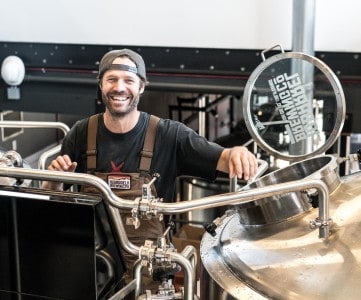
Source of Funding for Breweries
With regards to funding, the main sources of secure funding for a brewery are bank loans and angel investors.
Banks will want to review your business plan and gain confidence that you will be able to repay your loan and interest. To acquire this confidence, the loan officer will not only want to confirm that your financials are reasonable, but they will want to see a professional plan. Such a plan will give them the confidence that you can successfully and professionally operate a business.
Angel Investors
The second most common form of secure funding for a brewery is angel investors. Angel investors are wealthy individuals who will write you a check. They will either take equity in return for their funding or, like a bank, they will give you a loan. Venture capitalists will generally not fund a brewery. Private equity investors would consider a brewery or microbrewery business plan for funding if it has already reached a considerable scale.
Creative Funding Example
Liam Mulhall, CEO of Blowfly Beer, developed a customer base before a single drop of beverage had been brewed. He used the internet to include customers in the design process, allowing them to vote on everything from the label design to the ingredients. Throughout the process, he developed a loyal group of over 10,000 customers before he even began operating. In addition to selling Blowfly Beer, Mulhall also sold equity in his company to these customers-every time they bought a carton!
Blowfly’s innovative strategy had other benefits, as well. Because of the unique offering, they developed a sales base of very loyal customers, and their advertising expenses were essentially zero. Word of mouth allowed them to promote their registered customer base from an initial 140 people (friends of the founders) to more than 10,000. These customer-owners eventually began to receive dividends based on the sales of the beer. This created a further incentive to buy, drink, and recommend Blowfly to their friends.
Finish Your Business Plan Today!
How to write a brewery business plan.
All business plans should include the following 10 sections:
Executive Summary
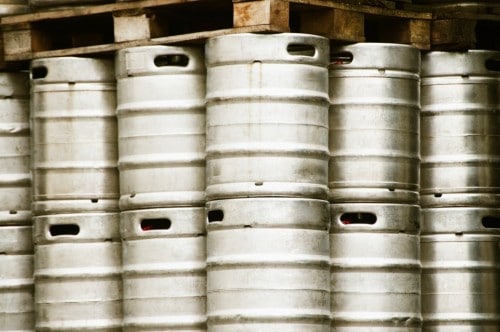
The goal of your Executive Summary is to quickly engage the reader. Explain to them the type of brewing company you are operating and the status; for example, are you a startup, do you have a craft brewery that you would like to grow, or are you operating a chain of brewpubs.
Next, provide an overview of each of the subsequent sections of your plan. For example, give a brief overview of the craft brewery industry. Detail your direct competitors. Give an overview of your target customers. Provide a snapshot of your marketing strategy and plan. Identify the key members of your team. And offer an overview of your financial plan.
Company Analysis
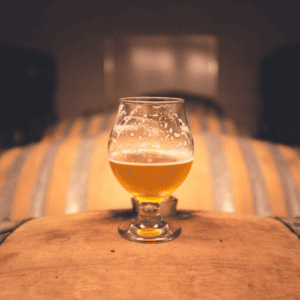
For example, you might operate one of the following 6 core types of breweries:
- Microbrewery: which is a brewery that produces less than 15,000 barrels of beer per year and sells 75% or more of its beer off-premises.
- Nano brewery: a brewery that produces less than 15,000 barrels of beer per year
- Brewpub: which is a restaurant-brewery combination that sells 25% or more of its beer on-site and offers food service
- Taproom Brewery: which sells 25% or more of its beer on-site, but does not offer food services
- Regional Brewery: a brewery that has annual beer production of between 15,000 and 6,000,000 barrels
- Contract Brewing Company: a business that contracts with another brewery to produce its beer
In addition to explaining the type of brewery you operate, the Company Analysis section of your business plan needs to provide background on the business.
Include answers to questions such as:
- When and why did you start the business?
- What milestones have you achieved to date? Milestones could include sales goals you’ve reached, new store openings, etc.
- Your business structure. Are you incorporated as an S-Corp? An LLC? A sole proprietorship? Explain your legal structure here.
Industry Analysis
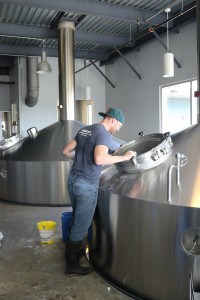
While this may seem unnecessary, it serves multiple purposes.
First, researching the brewing industry educates you. It helps you understand the market in which you are operating.
Secondly, market research can improve your strategy particularly if your research identifies market trends. For example, if there was a trend towards lighter beer consumption, it would be helpful to ensure your plan calls for plenty of lighter brew options.
The third reason for market research is to prove to readers that you are an expert in your industry. By conducting the research and presenting it in your plan, you achieve just that.
The following questions should be answered in the industry analysis section of your brewery business plan:
- How big is the brewery business (in dollars)?
- Is the market declining or increasing?
- Who are the key competitors in the market?
- Who are the key suppliers in the market?
- What trends are affecting the industry?
- What is the industry’s growth forecast over the next 5 – 10 years?
- What is the relevant market size? That is, how big is the potential market for your brewery. You can extrapolate such a figure by assessing the size of the market in the entire country and then applying that figure to your local or regional population.
Customer Analysis

The following are examples of customer segments: college students, sports enthusiasts, soccer moms, techies, baby boomers, etc.
As you can imagine, the customer segment(s) you choose will have a great impact on the type of brewery you operate. Clearly, baby boomers would want a different atmosphere, pricing, and product options, and would respond to different marketing promotions than college students.
Try to break out your target customers in terms of their demographic and psychographic profiles. With regards to demographics, including a discussion of the ages, genders, locations, and income levels of the customers you seek to serve. Because most breweries primarily serve customers living in the same city or town, such demographic information is easy to find on government websites.
Psychographic profiles explain the wants and needs of your target customers. The more you can understand and define these needs, the better you will do in attracting and retaining your customers.
Finish Your Brewery Business Plan in 1 Day!
Don’t you wish there was a faster, easier way to finish your business plan?
With Growthink’s Ultimate Brewery Business Plan Template you can finish your plan in just 8 hours or less!
Competitive Analysis
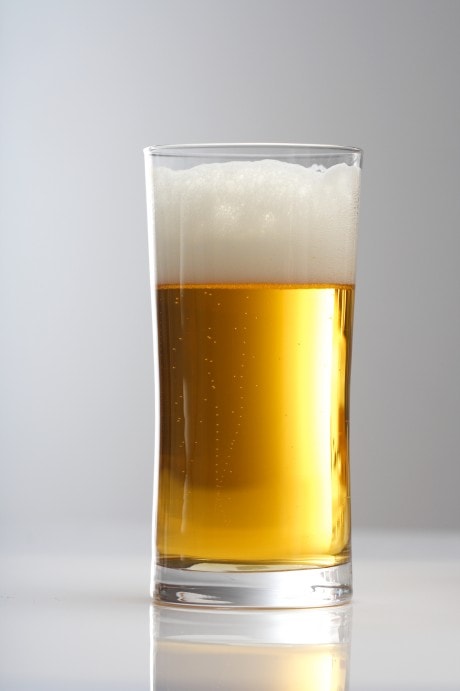
With regards to direct competition, you want to detail the other breweries with which you compete. Most likely, your competitors will be other breweries and brewpubs located in your region.
Indirect competitors are other options that customers have to purchase from you that aren’t in the same target market or industry but may offer similar products or services. This primarily includes restaurants (for brewpubs) and other products (spirits, wine) for microbreweries. You need to mention such competition to show you understand that not everyone who drinks alcohol frequents a brewery.
For each such competitor, provide an overview of their businesses and document their strengths and weaknesses. Unless you once worked at your competitors’ businesses, it will be impossible to know everything about them. But you should be able to find out key things about them such as:
- What types of customers do they serve?
- What products do they offer?
- What is their pricing (premium, low, etc.)?
- What are they good at?
- What are their weaknesses?
With regards to the last two questions, think about your answers from the customers’ perspective.
The final part of your competitive analysis section is to document your areas of competitive advantage. For example:
- Will you provide superior brewery products or services?
- Will you provide brewery products that your competitors don’t offer?
- Will you provide better customer service?
- Will you offer better pricing?
Think about ways you will outperform your competition and document them in this section of your plan.
Marketing Plan
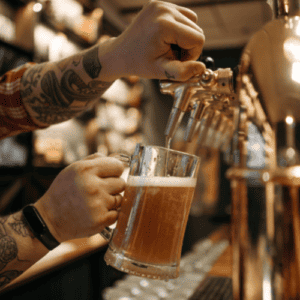
In the product section, you should reiterate the type of brewery that you documented in your Company Analysis. Then, detail the specific products you will be offering. For example, will you brew IPAs, pilsners, stouts, etc.?
Document the prices you will offer and how they compare to your competitors. Essentially in the product and price sub-sections, you are presenting the menu items you offer and their prices.
Place refers to the location of your brewery. Document your location and mention how the location will impact your success. For example, is your brewery located next to a heavily populated office building, or gym, etc.? Discuss how your location might provide a steady stream of customers. Also, if you operate or plan to operate kiosks, detail the locations where the kiosks will be placed.
The final part of your brewery marketing plan is the promotions section. Here you will document how you will drive customers to your location(s). The following are some promotional methods you might consider:
- Making your brewpub’s front store extra appealing to attract passing customers
- Establish a web presence
- Social media marketing
- Event marketing
- Advertising in local papers and magazines
- Reaching out to local bloggers and websites
- Local radio advertising
- Banner ads at local venues
Operations Plan
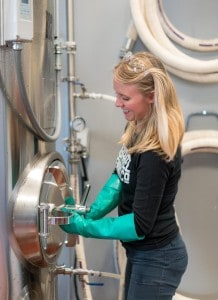
Everyday short-term processes include all of the tasks involved in running your brewery such as brewing beer, serving customers, procuring supplies, keeping the store clean, etc.
Long-term goals are the milestones you hope to achieve. These could include the dates when you expect to serve your X,000th customer, or when you hope to reach $X in sales. It could also be when you expect to hire your Xth employee or launch in new markets.
Management Team
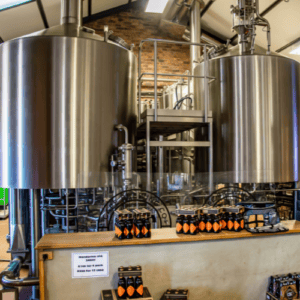
Ideally, you and/or your team members have direct experience in the brewery business. If so, highlight this experience and expertise. But also highlight any experience that you think will help your business succeed.
If your team is lacking, consider assembling an advisory board. An advisory board would include 2 to 8 individuals who would act as mentors to your business. They would help answer questions and provide strategic guidance. If needed, look for advisory board members with experience in breweries and/or successfully running retail and small businesses.
Financial Plan
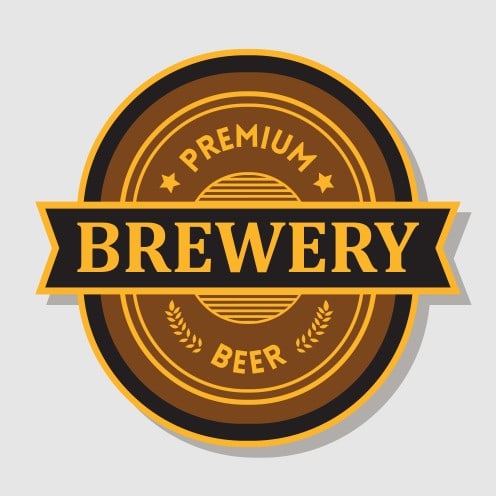
Income Statement
An income statement is more commonly called a Profit and Loss statement or P&L. It shows your revenues and then subtracts your costs to show whether you turned a profit or not.
In developing your income statement, you need to create a sales forecast. For example, will you serve 100 customers per day or 200? And will sales grow by 2% or 10% per year? As you can imagine, your choice of assumptions will greatly impact the financial forecasts for your business. As much as possible, conduct research to try to root your assumptions in reality.
Balance Sheet
While balance sheets include much information, to simplify them to the key items you need to know about, balance sheets show your assets and liabilities. For instance, if you spend $100,000 on building out your brewery, that will not give you immediate profits. Rather it is an asset that will hopefully help you generate profits for years to come. Likewise, if a bank writes you a check for $100.000, you don’t need to pay it back immediately. Rather, that is a liability you will pay back over time.
Cash Flow Statement
Your projected cash flow statement will help determine how much money you need to start or grow your business and make sure you never run out of money. What most entrepreneurs and business owners don’t realize is that you can turn a profit but run out of money and go bankrupt. For example, let’s say a company approached you with a $100,000 brewing contract, that would cost you $50,000 to fulfill. Well, in most cases, you would have to pay that $50,000 now for supplies, brewing equipment rentals, employee salaries, etc. But let’s say the company didn’t pay you for 180 days. During that 180 day period, you could run out of money.
In developing your Income Statement and Balance Sheets be sure to include several of the key start-up costs:
- New location build-out including design fees, construction, etc.
- Cost of brewing equipment
- Cost of ingredients and maintaining an adequate amount of supplies
- Payroll or salaries paid to staff
- Business insurance
- Taxes and permits
- Legal expenses
Attach your full financial projections in the appendix of your plan along with any supporting documents that make your plan more compelling. For example, you might include your store design blueprint or location lease.
Micro Brewery Business Plan Conclusion
Putting together a business plan for your brewing company is a worthwhile endeavor. If you follow the template above, by the time you are done, you will truly be an expert. You will really understand the brewery and microbrewery business, your competition, your business operations, and your potential customers. You will have developed a marketing plan and will really understand what it takes to launch and grow a successful brewery.
To further help you, we have other articles on key aspects of how to start your brewery . and running it effectively. Specifically, our brewery marketing plan will help you develop the best promotions strategy. Our brewery startup costs post will let you know what costs to expect.
Microbrewery Business Plan FAQs
What is the easiest way to complete my microbrewery business plan.
Growthink's Ultimate Brewery Business Plan Template allows you to quickly and easily complete your Brewery Business Plan.
Where Can I Download an Example Brewery Business Plan PDF?
You can download our example brewery business plan PDF template here . This is a sample business plan template you can use in PDF format.
Don’t you wish there was a faster, easier way to finish your Brewery business plan?
OR, Let Us Develop Your Plan For You
Since 1999, Growthink has developed business plans for thousands of companies who have gone on to achieve tremendous success. Click here to see how Growthink’s business plan services can give you a winning business plan.
Other Helpful Business Plan Articles & Templates


Brewery Business Plan Template & Example [Updated 2024]
Brewery Business Plan Template
If you want to start a brewery business or expand your existing brewery business, you need a business plan.
You can download our brewery business plan template (including a full, customizable financial model) to your computer here.
The following sample brewery business plan template gives you the key elements to include in a successful brewery business plan. It can be used to create a business plan for a craft brewery, a microbrewery business, or another brewery business concept.
Sample Business Plan Template for a Brewery
Below is a brewery business plan example with each of the key sections to help you write a brewery business plan for your own company.
I. Executive Summary
Business overview.
Based in [Location], [Company Name] brewery makes high quality, local beer that not only enriches celebrations and traditions, but also brings a touch of the extraordinary into daily life. It combines time-honored brewing with new methods and unique recipes to create a range of classic and craft beer everyone can enjoy. [Company Name] beer is the flavor of [Location].
Customer satisfaction is [Company Name]’s highest priority, with beer for every palate. [Company Name] has ambitions to become a household name; a go-to for all occasions.
Products Served
The following are the types of beer that [Company Name] produces:
- Belgian Witbier
Customer Focus
[Company Name] will primarily serve the residents who live within the city. The demographics of these target customers are as follows:
- 302,145 residents
- 79,567 workers
- Average income of $51,031
- 40% married
- 38% in Mgt./Professional occupations
- Median age: 39 years
Management Team
[Founder’s Name]’s expertise and experience is the [Company Name]’s most valuable asset. After graduating from the University of ABC where he earned a degree in Business, [Founder’s Name] worked at Samuel Adams. In his long experience in the industry, he acquired an in-depth knowledge of the ins and outs of running a brewery before he started [Company name].
[Company Name] will also employ an experienced assistant to help with production. He will also be trained by [Founder’s Name] so he can take over the brewery business when [Founder’s Name] is away.
Success Factors
[Company Name] is uniquely qualified to succeed due to the following reasons:
- There is currently no brewery in the community we are entering. In addition, we have surveyed the local population and received extremely positive feedback saying that they explicitly want to purchase our beer when launched.
- The management team has a track record of success in the craft brewery industry.
- The brewery business has proven to be a successful business in the United States.
Financial Highlights
[Company Name] is seeking a total funding of $400,000 to launch its brewery. The capital will be used for funding capital expenditures, manpower costs, marketing expenses and working capital.
Specifically, these funds will be used as follows:
- Brewery design/build: $200,000
- Working capital: $200,000 to pay for Marketing, salaries, and equipment costs until [Company Name] reaches break-even
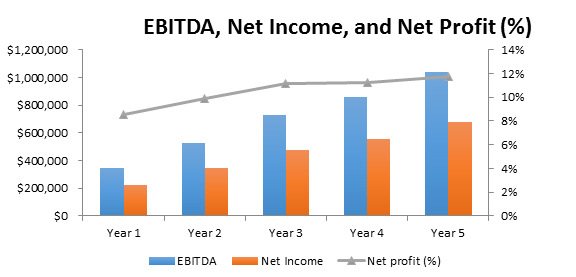
II. Company Overview
Who is [company name].
[Company Name] is a [Location]-based brewery that produces high quality, local beer that not only enriches celebrations and traditions, but also brings a touch of the extraordinary into daily life. It combines time-honored brewing with new methods and unique recipes to create a range of classic and craft beer everyone can enjoy. [Company Name] beer is the flavor of [Location].
[Company Name]’s History
Born in Portland, the beer capital of the world, [Founder’s Name] grew up brewing beer. In keeping with family tradition, he was trained in the art and science of handcrafting beer using family recipes and techniques. Upon relocating to [Location], [Founder’s Name] was dismayed to discover a lack of local craft brews. It didn’t take long for him to seize the opportunity to open his own brewery, [Company Name].
Since incorporation, the Company has achieved the following milestones:
- Acquired land
- Developed the company’s name, logo and website located at [website]
- Determined building, equipment and fixture requirements
- Began recruiting key employees
[Company Name]’s Products/Services
Iii. industry analysis.
Over the past five years, the brewwery industry has experienced significant change, with the rise of craft breweries, wineries and distilleries. Smaller, regional operators experienced substantial growth, provoking a slew of new operators to enter the industry.
The industry is also seeing heightened competition. Over the past decade, the industry experienced a substantial rise in industry players, mostly craft breweries. As these breweries continue to expand over the next five years, competition is expected to increase, and historically dominant players will likely struggle to maintain their control of industry revenue. As a result, the development of brand names over the next five years will be critical to major players’ success, both in competition among brewers and against substitute products, such as wine and spirits. Such developments will benefit larger players that run more cost-effective promotional campaigns. At the same time, younger beer drinkers, aged 21 to 30, are expected to increasingly experiment with and seek out unusual brews, which will provide opportunities for craft breweries and microbreweries to expand their market reach.
As competition escalates between breweries and the craft beer boom continues to normalize, the number of new entrants is projected to slow. Still, the number of industry enterprises is expected to increase at an annualized rate of 9.4%.
Over the next five years, the industry is forecast to have steady growth. Operators are expected to experience increases in demand from their largest markets, particularly on-premise channels, such as restaurants, bars and event spaces. Moreover, smaller operators that rely on in-person transactions through in-house bars and tasting rooms are expected to see demand, as many people seek social drinking experiences.
IV. Customer Analysis
Demographic profile of target market.
[Company Name] will serve the restaurants, hotels, grocery stores, and households within [location] and the immediately surrounding areas.
The precise demographics of the town in which our location resides is as follows:
Customer Segmentation
We will primarily target the following three customer segments:
- Local residents: Approximately 80,000 people live in the area, 80% of which are over the age of 21.
- Wholesale accounts: We will target restaurants, hotels and grocery stores to set-up wholesale accounts. These establishments will then sell our beer downstream to end consumers.
- Businesses: Local corporations hold parties and celebrations for special events and milestones. Although a small segment, this is a good place to increase the company’s brand awareness and market reach.
V. Competitive Analysis
Direct & indirect competitors.
The Gold Liquid Brewing Co. Established in 2017, The Gold Liquid Brewing Co is a family-owned and -operated craft microbrewery and gastropub. The operation consists of an 8 bbl brew house, 2 bbl pilot system, a small batch PicoBrew system, and a 3 kg coffee roaster.
In its taproom, Gold Liquid serves 34 in house brews on tap, as well as additional taps for guest ciders and 6 wines on draft. Its gastropub food menu features high-quality food designed to complement Good Liquid brews. Guests may eat in the bright dining room, or in the large, dog-friendly outdoor beer garden, which features picnic tables and outdoor games.
Midwestern Brewing Co. Established in 1998, Midwestern Brewing Co. is a brewpub offering its beers, both bottled and on tap, and serving lunch and dinner from locally-sourced ingredients whenever possible. Midwestern operates seven locations in Indiana, though not all serve food. The brewery offers complimentary tastings and monthly guest brewmasters.
Better Brewing Co. Established in 2018, Better Brewing Co. is a family-friendly, small batch brewery with a full kitchen on site serving gourmet style pub fare. It typically offers a weekly list of entertainment, music and food and drink specials. Guests may eat in the dining room, or in the dog-friendly beer garden.
Competitive Advantage
[Company Name] enjoys several advantages over its competitors. These advantages include:
- Client-oriented service: [Company Name] will have a full-time sales manager to keep in contact with our wholesale customers.
- Management: [Founder’s Name] has been extremely successful working in the industry and will be able to use his experience to create the best tasting beers. His unique qualifications will serve customers in a much more sophisticated manner than [Company Name’s] competitors.
- Transparency: To continue to assure customers of the quality of [Company Name]’s products, customers are welcome to tour the brewery for a beer tasting and brewery experience.
VI. Marketing Plan
The [company name] brand.
The [Company Name] brand will focus on the Company’s unique value proposition:
- Offers the finest beer at a competitive price
- Has a convenient location in the heart of the city
- Provides excellent customer service
Promotions Strategy
[Company Name] expects its target market to be individuals working and/or living within [state]. [The Company’s] promotions strategy to reach these individuals includes:
Sampling [Company Name] employees will initially give free beer samples to enable customers to taste the quality and variety of our beer and learn about us.
Ongoing Customer Communications [Company Name] will maintain a website and publish a monthly email newsletter to tell customers about new events, products, and more.
Pre-Opening Events Before opening the brewery, [Company Name] will organize pre-opening events designed for prospective customers, local merchants and press contacts. These events will create buzz and awareness for [Company Name] in the area.
Online Marketing [Company name] will invest resources in two forms of geographically-focused internet promotion—organic search engine optimization and pay-per-click advertising. The Company will develop its website in such a manner as to direct as much traffic from search engines as possible. Additionally, it will use highly-focused, specific keywords to draw traffic to its website, where potential clients will find a content-rich site that presents [Company name] as the trustworthy, well-qualified brewery that it is.
VII. Operations Plan
Functional roles.
In order to execute on [Company Name]’s business model, the Company’s employees divide the following roles:
Operation Functions
- Production/brewing
- Deliveries and business operations
- Sales and Marketing
Administrative Functions
- General & administrative functions including marketing, bookkeeping, etc.
- Hiring and training staff
[Company name]’s long term goal is to become the dominant producer of quality beer in the [Location] area. We seek to be the standard by which other brewers are judged.
VIII. Management Team
Management team members.
[Founder’s Name]’s expertise and experience is [Company Name]’s most valuable asset. After graduating from the University of ABC where he earned a degree in Business, [Founder’s Name] worked for a major national brewer. In his long experience in the industry, he acquired an in-depth knowledge of the ins and outs of running a brewery before he started [Company name].
[Company Name] will also employ an experienced assistant to help with production. He will also be trained by [Founder’s Name] so he can take over the business when [Founder’s Name] is away.
Hiring Plan
[Founder’s Name] will serve as [Company Name]’s manager. In order to launch the brewery, we need to hire the following personnel:
- Brewery workers: 5 full-time to start
- Assistant Manager: 1 full-time to handle the day-to-day operations
- Delivery personnel: 1 full-time
IX. Financial Plan
Revenue and cost drivers.
[Company Name]’s revenues will come primarily from the sales of beverages to its customers.
The major costs for the company are packaging costs, salaries and supplies. In the initial years, the company’s marketing spend will be high, as it establishes itself in the market.
Capital Requirements and Use of Funds
- Store design/build: $200,000
Key Assumptions
5 Year Annual Income Statement
5 Year Annual Balance Sheet
5 Year Annual Cash Flow Statement
Comments are closed.

- Business Plan for Investors
- Bank/SBA Business Plan
- Operational/Strategic Planning Services
- L1 Visa Business Plan
- E1 Treaty Trader Visa Business Plan
- E2 Treaty Investor Visa Business Plan
- EB-1 Business Plan
- EB-2 NIW Business Plan
- EB-5 Business Plan
- Innovator Founder Visa Business Plan
- Start-Up Visa Business Plan
- Expansion Worker Visa Business Plan
- Manitoba MPNP Visa Business Plan
- Nova Scotia NSNP Visa Business Plan
- British Columbia BC PNP Visa Business Plan
- Self-Employed Visa Business Plan
- OINP Entrepreneur Stream Business Plan
- LMIA Owner Operator Business Plan
- ICT Work Permit Business Plan
- LMIA Mobility Program – C11 Entrepreneur Business Plan
- USMCA (ex-NAFTA) Business Plan
- Franchise Business Plan
- Landlord business plan
- Nonprofit Start-Up Business Plan
- USDA Business Plan
- Cannabis business plan
- Ecommerce business plan
- Online boutique business plan
- Mobile application business plan
- Daycare business plan
- Restaurant business plan
- Food delivery business plan
- Real estate business plan
- Business Continuity Plan
- Pitch Deck Consulting Services
- Financial Due Diligence Services
- ICO whitepaper
- ICO consulting services
- Confidential Information Memorandum
- Private Placement Memorandum
- Feasibility study
- Fractional CFO
- How it works
- Business Plan Examples
Brewery Business Plan Template
NOV.11, 2016

Brewery business plan for starting your own business
Do you know that the global alcohol consumption has increased by as much as 10% from 1990 to 2017. Experts of the industry are predicting an ever faster increase. It is being forecasted that this number will go up another 10% by the end of this decade.
Add to that the fact that the global average consumption for all people over the age of 15 currently stands at 6.5 liters of pure alcohol a year or around 55 1-liter bottles of standard 12% alcohol content wine.
We will be giving you a business plan for brewery that you can use to start a brewery business. Before we tell you how to open a brewery, you need to know that we will be using tried and tested marketing strategies restaurants .
Executive Summary
2.1 the business.
Joe’s Liquor will be a registered and insured alcohol producer based in Dougherty, Texas. It will be owned by Joe Colombo. The business will make beer, whiskey, and non-alcoholic malted beverages. The products will be supplied all over the state of Texas in the start and the business will expand to other states in the years to come.
2.2 Management of Brewery Business
In order to start a brewery, the first thing you need to do is to have a strong management plan for the business. Joe will hire 5 managers and will himself act as the chief executive of the business.
The managers will be responsible for marketing, procurement, research, sales, and operations. Every one of the managers will be responsible for the people working in his department and will report all important matters to Joe as and when they show up.
All brewery business plans need to allow for innovation. The research manager will be given enough budget to fuel research and come up with new products.
2.3 Customers of Brewery Business
After taking the advice of various business consultants , Joe has decided to provide the following products to the following customers from his brewery business.
- Bars and pubs.
- Hotels and casinos.
- Liquor stores.
- Grocery stores that sell liquor.
2.4 Business Target
If you want to know how to start a brewery, you need to know the goals and targets.
The target of Joe’s Liquor is to:
- Establish themselves as a trustworthy brand.
- Be the largest supplier of liquor in Texas 5 years after starting.
- Innovating and making drinks specific to them.
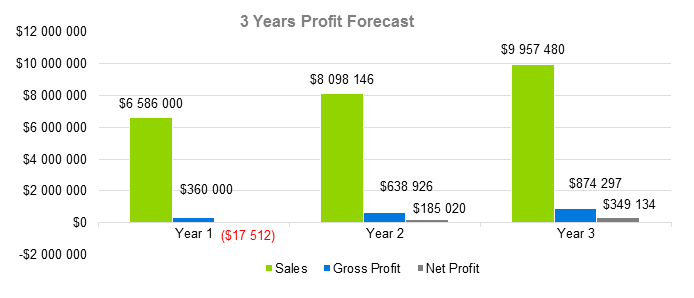
Company Summary
3.1 company owner.
Joe Colombo will be the owner of the company. He is not only the sole financer of this venture but also has a vast experience in the field too. His father owned and operated the largest brewery in the US after prohibition. Joe knows the business inside out.
3.2 Why the Brewery Business is being started?
Joe has a passion for making the best liquor. This brewery business plan example also focuses on the fact that Joe is starting this business because it is a lucrative one. A single barrel of fine beer can bring as much as $150 in revenue and costs under $50 to make.
This means that if Joe’s Liquor manages to make even 100 barrels a week, they can turn in more than $10,000 in profits, every week. This lucrative scope of profit is one of the key reasons Joe is starting a brewery. This plan is easily more profitable than any business plan online store .
3.3 How the Brewery Business will be started?
Step1: Planning Phase
Planning is the first step in starting a craft brewery. In this phase, everything from the location of the plant to the sales and marketing will be tentatively planned. This brewery business plan sample will cover all the aspects of planning needed to start a brewery.
Step2: Establishing a Brand
Unlike an online dating business plan , a brewery needs to make a brand. People only buy booze that is branded. We’ll focus our marketing effort at establishing a strong brand.
Step3: Establish Sales Office
The moment the brewery starts churning out beer and wine, you’ll have to have a sales office where you can orchestrate the sales form.
Step4: Establish a Web Presence
You need to be present on the internet to make sure that people know of your existence and what your brand is about. Just like a video games business plan , web presence is a must.
Step5: Promote and Market
You will need to market the business good enough for people to know that you mean business, serious business.
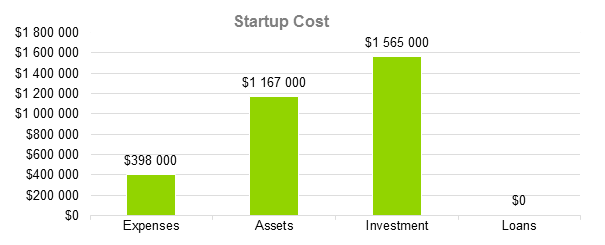
Services of Brewery Business
The next thing we need to cover in this brewery business plan template are the services that will be provided by the business. Because, before you can even get to start your own brewery, it is important for you to know the services. .
As a brewery is more of a products business than a services one, making it much like a business plan for an internet startup , the services will be more like products.
Here’s a list of services that Joe’s Liquor will be providing.
- Beer and Wine Supply to Bars – Bars will be one of the largest consumers of our products. We will supply beer and wine of the highest quality and will make sure that we never delay the delivery. Bars will be our long-term and permanent customers as they have customers who demand the same beer once they start liking it.
- Liquor Supply to Hotels – The next service we’ll be providing will be supplying beer, alcohol, and other drinks to hotels. These will not be in a large number but each one of them will buy quite a bit of our product. This will make them one of our major streams of revenue.
- Medical Alcohol Supply – As doctors need a lot of alcohol for different purposes, we will be producing medical grade denatured alcohol to supply to the hospitals. This will establish Joe’s Liquor as a company with concern for the society.
- Alcohol Supply to End Consumer – We will open factory outlets in different cities to sell our product on a discounted price. This will be done to increase brand awareness and attract more customers.
Marketing Analysis of Brewery Business
Immigration business plan.
Having an in-depth knowledge of the market you are going to enter is of paramount importance. This brewery business plan model will cover all the aspects of starting a brewery business plan including the marketing analysis.
If we look at the trends on the consumption of alcohol over the last couple of decades, we can notice a steady increase in the consumption of this stuff. However, there are also hundreds of small and large breweries in the US making beer and wine. It makes this industry not so easy to penetrate. If you want to make serious profits, your business plan brewpub needs to focus a lot on innovation and bringing novelty to the game. Running a successful brewery without that is just not possible.
One of the most important steps to opening a brewery include an in-depth study of the following. If you want to know how to start brewery business, you need to focus on these.
5.1 Market Trends
The liquor industry is a mind boggling $1.47trillion dollar market that is going to see a whopping 10% increase in consumption within this decade. If we have a look at the landscape of the industry in the US, it can be noted that people are preferring locally made beer and wine over the exotics. This is a promising fact for anyone trying to enter the liquor market in the USA.
5.2 Marketing Segmentation
The marketing segmentation of Joe’s Liquor will look something like this:
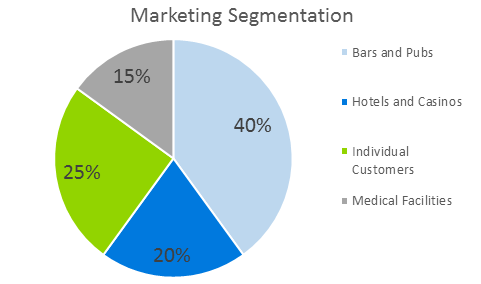
5.2.1 Bars and Pubs
Some of the most important and permanent customers of the products of Joe’s Liquor will be the bars and pubs all over the state of Texas. These institutions will buy the product in bulk and will most probably make a long-term business relationship with the manufacturer. We will offer them a discounted rate on bulk purchase.
5.2.2 Hotels and Casinos
This segment of the market will also be bulk customer, but they will not buy very much at the start. People going to these places generally prefer established brands. We will make a brand in time but we’ll hopefully not get a lot of business from this market segment in the starting years.
5.2.3 Individual Customers
To cater the needs of drinkers we’ll open factory outlets in the major towns where people can buy the stuff. These sales will also be little in the start but will soon grow once we prove the quality.
5.2.4 Medical Facilities
This market segment will be an atypical one. We hope to make a name in this area because there is not much of a competition in this market segment.
5.3 Business Target
- To be one of the leading beer and wine producers in the US.
- Opening three new manufacturing units by the end of the first year.
- Establishing a brand and making a brand image that will drive sales and earn us loyal customers.
5.4 Product Pricing
We will price the products as per the trends of the industry. However, discounts will be provided in the start and to bulk buyers. The discounts for bars, hotel, pubs, casinos, and liquor stores will be negotiated and decided on a case-to-case basis.
Marketing Strategy of Brewery Business
The next thing to include in a brewery business plan marketing strategy is the marketing strategy that we will be adopting. This is because you need to have a solid marketing plan for <staring>starting your own brewery business plan to be successful.
We will aim our marketing efforts at highlighting what we provide that others do not. This is the only way to enter this market. Unlike a business plan for a video game company , this marketing plan needs to rely on strategic marketing owing to the competition.
6.1 Competitive Analysis
- Joe’s Liquor will provide the best beer in the whole idea and will offer new flavors that competitors do not offer.
- We will keep the prices low in the start to make sure we get customers.
- We will focus on delivering consistently good quality throughout the years of us being in the business.
- We will specifically focus on the medical market as that is still a relatively untapped segment of the alcohol market.
6.2 Sales Strategy
- We’ll be using all the digital marketing channels to market the brand.
- We will offer discounts and promotions for all of the market segments in the start.
- Our focus in the first year will be to build up sales as best we can even at the least profit margin.
6.3 Sales Monthly
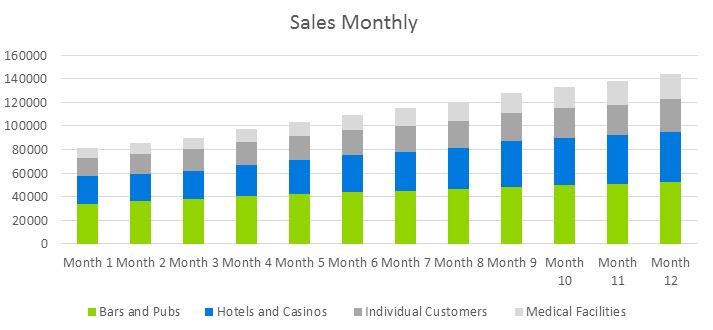
6.4 Sales Yearly
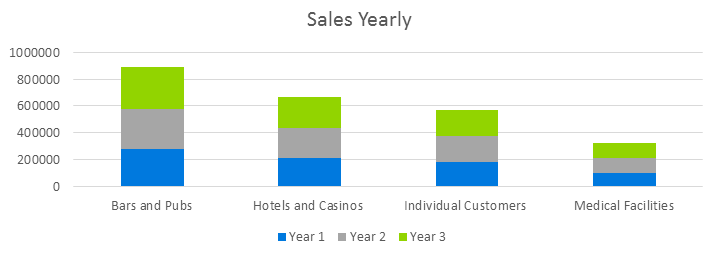
6.5 Sales Forecast
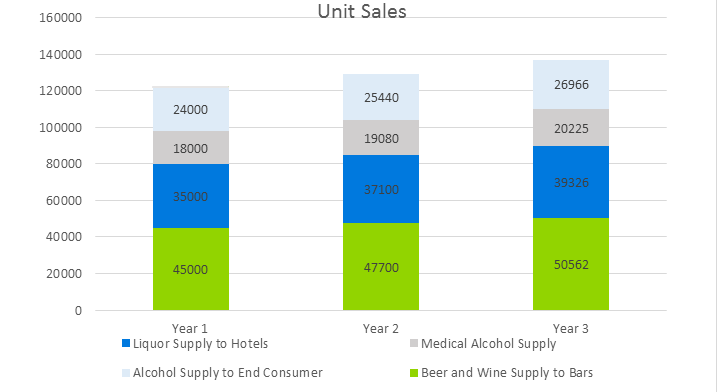
Personnel plan
If you need to know how to start a brewery business plan, a personnel plan is one of the most important aspects of it. Unlike starting a virtual assistant business , this business requires a lot of skilled staff to be fully functional.
7.1 Company Staff
- Joe Colombo will be the CEO.
- 5 Managers for Operations, Procurement, Liaison, Operations, and sales.
- 1 Engineer to help with running the plant.
- 4 Operators to run the plant.
- 2 Truck drivers.
- 3 Car drivers.
- 3 Security guards.
7.2 Average Salary of Employees
Financial plan.
The last and probably the most important thing needed to make this business plan is to have an estimate of start a brewery cost. Although the actual costs can only be known once the business starts, here are some that you need to keep in mind.
- The cost of leasing/buying the land to set up the brewery.
- The cost of machinery needed to make the plant operational.
- The salaries of the staff for the first year.
- The cost of marketing and promotion.
- The cost of buying/leasing vehicles for delivery.
- The cost of equity if the business is being started on loaned money.
8.1 Important Assumptions
8.2 break-even analysis.
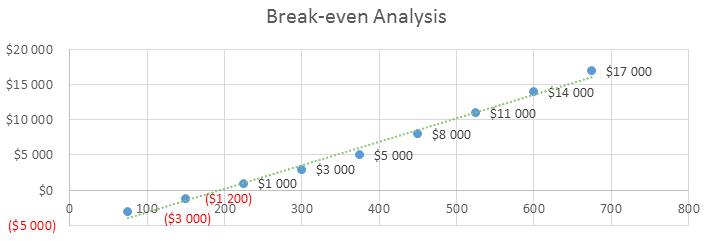
8.3 Projected Profit and Loss
8.3.1 profit monthly.
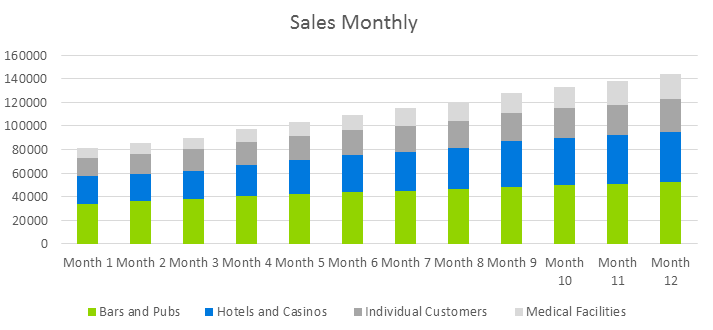
8.3.2 Profit Yearly
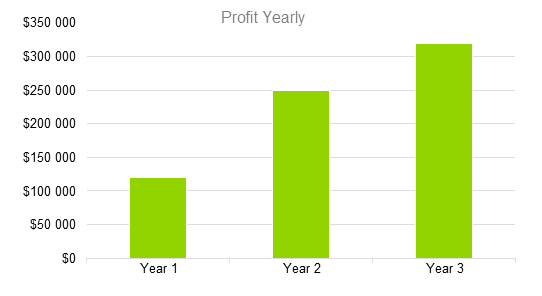
8.3.3 Gross Margin Monthly
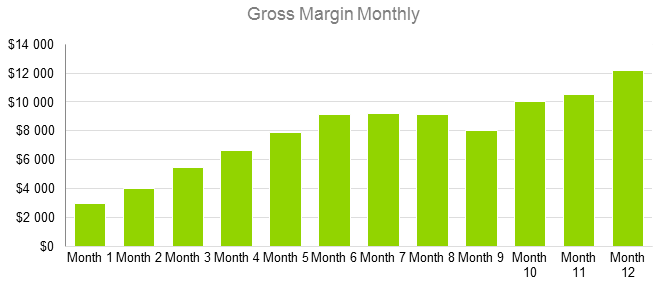
8.3.4 Gross Margin Yearly
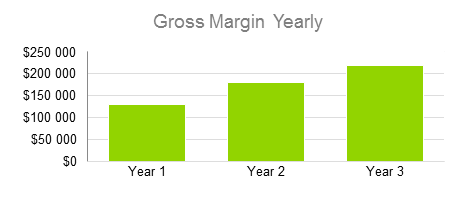
8.4 Projected Cash Flow
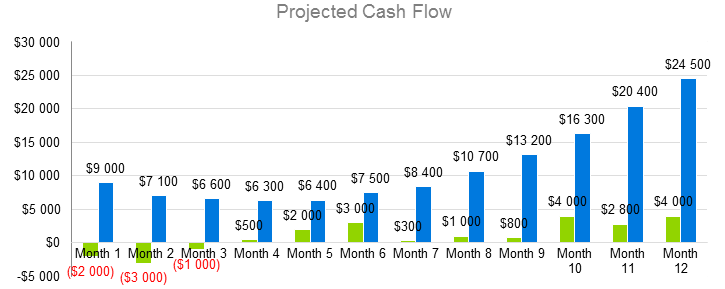
8.5 Projected Balance Sheet
8.6 business ratios.
Download Brewery Business Plan Sample in PDF
OGSCapital’s team has assisted thousands of entrepreneurs with top-rate business plan development, consultancy and analysis. They’ve helped thousands of SME owners secure more than $1.5 billion in funding, and they can do the same for you.

Add comment
E-mail is already registered on the site. Please use the Login form or enter another .
You entered an incorrect username or password
Comments (0)
mentioned in the press:
Search the site:
OGScapital website is not supported for your current browser. Please use:


How To Write a Craft Beer Store Business Plan + Template

Creating a business plan is essential for any business, but it can be especially helpful for craft beer stores that want to improve their strategy and/or raise funding.
A well-crafted business plan not only outlines the vision for your company, but also documents a step-by-step roadmap of how you are going to accomplish it. In order to create an effective business plan, you must first understand the components that are essential to its success.
This article provides an overview of the key elements that every craft beer store owner should include in their business plan.
Download the Ultimate Business Plan Template
What is a Craft Beer Store Business Plan?
A craft beer store business plan is a formal written document that describes your company’s business strategy and its feasibility. It documents the reasons you will be successful, your areas of competitive advantage, and it includes information about your team members. Your business plan is a key document that will convince investors and lenders (if needed) that you are positioned to become a successful venture.
Why Write a Craft Beer Store Business Plan?
A craft beer store business plan is required for banks and investors. The document is a clear and concise guide of your business idea and the steps you will take to make it profitable.
Entrepreneurs can also use this as a roadmap when starting their new company or venture, especially if they are inexperienced in starting a business.
Writing an Effective Craft Beer Store Business Plan
The following are the key components of a successful craft beer store business plan:
Executive Summary
The executive summary of a craft beer store business plan is a one to two page overview of your entire business plan. It should summarize the main points, which will be presented in full in the rest of your business plan.
- Start with a one-line description of your craft beer store company
- Provide a short summary of the key points in each section of your business plan, which includes information about your company’s management team, industry analysis, competitive analysis, and financial forecast among others.
Company Description
This section should include a brief history of your company. Include a short description of how your company started, and provide a timeline of milestones your company has achieved.
If you are just starting your craft beer store , you may not have a long company history. Instead, you can include information about your professional experience in this industry and how and why you conceived your new venture. If you have worked for a similar company before or have been involved in an entrepreneurial venture before starting your craft beer store, mention this.
You will also include information about your chosen craft beer store business model and how, if applicable, it is different from other companies in your industry.
Industry Analysis
The industry or market analysis is an important component of a craft beer store business plan. Conduct thorough market research to determine industry trends and document the size of your market.
Questions to answer include:
- What part of the craft beer store industry are you targeting?
- How big is the market?
- What trends are happening in the industry right now (and if applicable, how do these trends support the success of your company)?
You should also include sources for the information you provide, such as published research reports and expert opinions.
Customer Analysis
This section should include a list of your target audience(s) with demographic and psychographic profiles (e.g., age, gender, income level, profession, job titles, interests). You will need to provide a profile of each customer segment separately, including their needs and wants.
For example, the customers of a craft beer store may include:
- young professionals who are looking for a place to gather after work
- Customers who are looking for a place to enjoy distinctive beer flavors
- Customers who are interested in learning about and tasting different types of craft beer
You can include information about how your customers make the decision to buy from you as well as what keeps them buying from you.
Develop a strategy for targeting those customers who are most likely to buy from you, as well as those that might be influenced to buy your products or craft beer store services with the right marketing.
Competitive Analysis
The competitive analysis helps you determine how your product or service will be different from competitors, and what your unique selling proposition (USP) might be that will set you apart in this industry.
For each competitor, list their strengths and weaknesses. Next, determine your areas of competitive differentiation and/or advantage; that is, in what ways are you different from and ideally better than your competitors.
Below are sample competitive advantages your craft beer store may have:
- Unique selection of beers
- Excellent customer service
- Knowledgeable staff who can share beer-making stories
- High-quality beer
- Inviting atmosphere
Marketing Plan
This part of the business plan is where you determine and document your marketing plan. . Your plan should be clearly laid out, including the following 4 Ps.
- Product/Service : Detail your product/service offerings here. Document their features and benefits.
- Price : Document your pricing strategy here. In addition to stating the prices for your products/services, mention how your pricing compares to your competition.
- Place : Where will your customers find you? What channels of distribution (e.g., partnerships) will you use to reach them if applicable?
- Promotion : How will you reach your target customers? For example, you may use social media, write blog posts, create an email marketing campaign, use pay-per-click advertising, launch a direct mail campaign. Or, you may promote your craft beer store via word-of-mouth marketing.
Operations Plan
This part of your craft beer store business plan should include the following information:
- How will you deliver your product/service to customers? For example, will you do it in person or over the phone only?
- What infrastructure, equipment, and resources are needed to operate successfully? How can you meet those requirements within budget constraints?
The operations plan is where you also need to include your company’s business policies. You will want to establish policies related to everything from customer service to pricing, to the overall brand image you are trying to present.
Finally, and most importantly, in your Operations Plan, you will lay out the milestones your company hopes to achieve within the next five years. Create a chart that shows the key milestone(s) you hope to achieve each quarter for the next four quarters, and then each year for the following four years. Examples of milestones for a craft beer store include reaching $X in sales. Other examples include expanding to a second location, or launching an online store.
Management Team
List your team members here including their names and titles, as well as their expertise and experience relevant to your specific craft beer store industry. Include brief biography sketches for each team member.
Particularly if you are seeking funding, the goal of this section is to convince investors and lenders that your team has the expertise and experience to execute on your plan. If you are missing key team members, document the roles and responsibilities you plan to hire for in the future.
Financial Plan
Here you will include a summary of your complete and detailed financial plan (your full financial projections go in the Appendix).
This includes the following three financial statements:
Income Statement
Your income statement should include:
- Revenue : how much revenue you generate.
- Cost of Goods Sold : These are your direct costs associated with generating revenue. This includes labor costs, as well as the cost of any equipment and supplies used to deliver the product/service offering.
- Net Income (or loss) : Once expenses and revenue are totaled and deducted from each other, this is the net income or loss.
Sample Income Statement for a Startup Craft Beer Store
Balance sheet.
Include a balance sheet that shows your assets, liabilities, and equity. Your balance sheet should include:
- Assets : All of the things you own (including cash).
- Liabilities : This is what you owe against your company’s assets, such as accounts payable or loans.
- Equity : The worth of your business after all liabilities and assets are totaled and deducted from each other.
Sample Balance Sheet for a Startup Craft Beer Store
Cash flow statement.
Include a cash flow statement showing how much cash comes in, how much cash goes out and a net cash flow for each year. The cash flow statement should include:
- Cash Flow From Operations
- Cash Flow From Investments
- Cash Flow From Financing
Below is a sample of a projected cash flow statement for a startup craft beer store .
Sample Cash Flow Statement for a Startup Craft Beer Store
You will also want to include an appendix section which will include:
- Your complete financial projections
- A complete list of your company’s business policies and procedures related to the rest of the business plan (marketing, operations, etc.)
- Any other documentation which supports what you included in the body of your business plan.
Writing a good business plan gives you the advantage of being fully prepared to launch and/or grow your craft beer store . It not only outlines your business vision but also provides a step-by-step process of how you are going to accomplish it.
A well-executed business plan will give you the best chance at success and keep you organized and on track as your craft beer store grows.
Now that you understand how to write a craft beer store business plan, it’s time to get started on yours.
Finish Your Business Plan in 1 Day!
Wish there was a faster, easier way to finish your business plan?
With our Ultimate Business Plan Template you can finish your plan in just 8 hours or less!
Brewery Business Plan Guide in 2024
What is a brewery business plan, why does your brewery need a brewery business plan.
- Do you plan to stay in one place to develop your business or do you want to expand the number of breweries in the next few years?
- Consider the number of people you hire now and the number of people you want to hire when you reach your sales goals.
- Do you consider selling beer only on-site at your location, or offering your beer in trending grocery stores and restaurants?
Business decision
What should be included in your brewery business plan, executive summary, brewery details, brewery concept.
When discussing craft beer and micro-brewed beer, they have similarities, but there are also differences. Different people have different understandings of terms because they are too confusing. However, Micet Craft hopes to help craft beer lovers to distinguish them here. What is the difference between various types of breweries? Microbrewery The microbrewery is classified according
Mission statement
Products and services, critical success factor, legal structure, short-term and long-term goals, menu and service.
- Attraction: What nearby features will affect your brewery?
- Competition: Are there other breweries or related companies in this area?
- Demographics: What kind of people will live or work nearby?
Visual effects
Market analysis.
- How much beer is on their menu?
- How often do their menus rotate?
- Do they offer monthly beer clubs or memberships?
- Do they have a customer loyalty program?
- Do they provide a tour of the brewing process?
- Are their craft drinks available at the local grocery store or can only be purchased from their bar?
Market segments
Market trend, organization, product inventory, marketing strategy.
- How will you ensure that customers rate your brewery very highly?
- How do you upsell to help increase the value of each customer per visit?
- How do you ensure that customers will continue to buy products in your brewery?
Business strategy
- Location: Explain where your brewery will be? How big will the facility be? Why is this the perfect location? How will you refurbish this location and so on?
- Quality control: Maintaining product quality is critical to the success of the brewery. Failure to grasp the latest product status may result in video inspection violations. You need to elaborate on the steps you will take to ensure that you can always produce high-quality products.
- Customer service: The brewery is a service-oriented enterprise that provides services to customers. Customer service is the key to ensuring that customers are satisfied enough for the next purchase. You need to describe how you will perform customer service and how you will handle any customer complaints.
- Sales process: Explain in detail the process from the moment the customer enters the door to the receipt of your product and finally leaves. Who will guide them where to sit? How to provide services for them? How is the meal fee charged? What will happen after they leave?
- Staffing: Finally, you need to elaborate on your staffing plan. Consider who you need to hire to run your brewery properly. When will you hire them? How will you train them? How much will you pay them?
Sales strategy
- What are your production costs?
- What are the costs associated with each product?
- What is the market price of similar products? (I.e. what price your competitors charge)
- How does your pricing compare to market prices?
- How is your pricing competitive?
- What kind of return on investment do you expect from this pricing strategy, and in what time period?
Online promotion
- Social media: If you plan to create and maintain social media accounts such as Twitter, Instagram, and Facebook, please explain how you will use them to promote your business and brand.
- Website: Describe the overall concept of your website and how it aligns with your brand. Provide a visual model, including the main elements and design style. In addition, please indicate whether you plan to build a site internally or pay for professional services.
- Advertising: List all your paid digital advertising channels, such as review sites, banner ads, and social media ads. If you will work with an agency or contractor, please list them and what they will do for you in this section.
Traditional promotion
Business operations, team and staff, finance prediction.
- Revenue (forecast sales)
- Controllable cost (production cost, labor cost)
- Expenses (rent, supplies, utilities, marketing, etc.)
- Start-up costs (costs related to opening a brewery, such as the purchase cost of brewery equipment)
Business plan summary
- Why your business is successful-repeat in a few sentences how your brewery is different and why your business is successful.
- Requirements for success-if you need funds, please repeat the question here.
- Thank you letter-thank your audience for reading your brewery business plan and reminding them that you value their time and feedback.
Beer Brewery Equipment Manufacturer The brewing supplies provided by Micet Craft can support your brewing needs from small batches of micro beer brewing equipment to 100 barrels capacity. Micet Craft has reached cooperation with many breweries around the world, we can design and manufacture professional brewing systems for breweries, including cellar beer brewing equipment and other
China stainless steel fermentation vessels manufacturer The fermentation tank is where the beer carry out the fermentation process, it provides a place suitable for life activities and metabolism for microorganisms. To adapt to the use of different sizes of breweries, Micet Craft produced a variety of sizes and specifications of fermentation tanks. Customers can choose
Professional bright Beer tank manufacturer from China The bright tank is a vessel for storing and carbonated beer, it is also called the brite tank. The bright tank is an important part of the workflow of professional beer brewers. It can be used to store and carbonate beer, thus eliminating the trouble of cleaning beer
China brewing equipment manufacturer and suppliers Micet Craft has cooperated with breweries in many countries around the world to provide them with brewing equipment. We provide customers with turnkey brewery solutions, which include designing, manufacturing and installing customized breweries. The Micet Craft team has decades of experience in the manufacturing of brewing equipment, we not
Best brewhouse equipment manufacturer from china Brewing good beer requires brewhouse equipment. Whether you are brewing beer for home, business or brewery, Micet Craft can provide a turnkey solution according to the daily output you need. We have brewhouse equipment with 2 vessels, 3 vessels and 4 vessels, the unique design allows you to do decoction
Professional beer filling machine manufacturer Beer filling machine is the core equipment of the beer production line. Our beer filling system uses stainless steel as the production material. Stainless steel is not easy to wear, and it is easy to clean. Micet Craft provides you with a cheap and efficient way of filling beer. We
Best beer brewing system manufacturer from china Micet Craft is a professional beer brewing system manufacturer in China. We mainly produce high-end customized turnkey brewing systems. Whether you are planning to open a nano-brewery, microbrewery, or commercial brewery, we can provide you with the most complete turnkey solution. Our beer brewing systems are all price-competitive
Leave a Comment Cancel Reply
Your email address will not be published. Required fields are marked *
Save my name, email, and website in this browser for the next time I comment.
Contact Micet Craft
We will contact you within 1 working day, please pay attention to the email with the suffix “@micetbrewing.com”.

IMAGES
VIDEO
COMMENTS
An organizational chart example for a taproom brewery. 6. Financial Plan. The financial plan is perhaps, with the executive summary, the most important section of any business plan for a brewery. Indeed, a solid financial plan tells lenders that your business is viable and can repay the loan you need from them.
2. Create an operational plan. The heart of your brewery business lies in its day-to-day operations. Begin with detailing the brewing schedules, capturing the intricacies of beer production, and then customer service operations. Your operations plan should extend beyond brewing. Include managing supply chains, maintaining brewing equipment, and ...
Business Plan Resources for Breweries. Many of the discussions we have at the Brewers Association (BA) revolve around resources and ideas that are specific to the beer industry. We focus on technical brewing, acquiring the right ingredients, building a brand, marketing beers, passing OSHA inspections, and complying with the TTB, among other things.
Download our FREE Craft Brewery Business Plan Template, designed to help you brew up a successful strategy. Perfect for entrepreneurs ready to tap into the booming craft beer market! ... Here is a free business plan sample for a craft brewery January 29, 2024.
The craft brewery industry is experiencing explosive growth, with sales accounting for 24% of the U.S. beer market which is worth over $114 billion.To truly achieve success as a brewery owner or manager in this competitive landscape, you'll need a brewery business plan.
The global beer market stood at a value of 623.2 billion dollars in 2020 and is expected to grow at a rapid rate thereafter too. The main reason behind the rise in cultural changes and the growing acceptance of alcohol across the globe. Moreover, the brewery business is growing due to differences in preferences between alcohol-free to low ...
Part of your brewery business plan is figuring out all the necessary equipment. This should be related to your menu, your brewery size, location, and how you plan to operate. When planning your brewing equipment, consider the volume of beer you need to brew and have a clear plan for how you will be able to sell this.
The executive summary of a brewery business plan is a one to two page overview of your entire business plan. It should summarize the main points, which will be presented in full in the rest of your business plan. Start with a one-line description of your brewery company. Provide a short summary of the key points in each section of your business ...
Example 3: pre-sale "beer of the month" or mugs for a "mug club" to provide a discount for the first year (or lifetime) based on a pre-launch subscription fee. Example 4: Social Media & Email signups. Build a local (and broader) following by documenting/sharing the process of brewing, building, launching the brewery.
But, if your brewery is going to follow a standard way of doing things in the industry (like a craft brewery, a microbrewery, or a brewpub), then you can go ahead and start creating your business plan. Step 3: Create a Brewery Business Plan Structure. Follow a ready-made structure to organize your business plan for brewery effectively.
Below is a brewery business plan example to help you write your brewery business plan: Executive Summary Business Overview. Mountain Craft Beer is a startup brewery located in Boulder, Colorado. The company is founded by Richard and Susan Williams, long-time craft beer enthusiasts who are ready to venture out and start their own brewing business.
By the 2010s, craft beer madness was in full swing, with beer aficionados flocking to their local breweries to taste their seasonal wares. 15 years later, breweries have continued bringing in crowds of beer aficionados, and the craft beer industry keeps growing. Writing a Business Plan for Breweries
Total start-up capital and expenses (including legal costs, logo design, stationery and related expenses) came to approximately $41,700. Start-up assets required and utilized included brewing plant and machinery, pick-ups, office furniture, personal computers and other office equipment. This figure comes to $840,000.
It helps to define hidden costs, expose holes in your ideas and force all parts of the plan to work in concert. Don't be afraid to ask questions of brewers and breweries. You'd be surprised at what information and tips you can get. Research trademarks heavily if the name of your brewery is a critical component of your plan.
Industry Analysis. The Brewery industry in the United States is currently experiencing significant growth and has become a major player in the country's economy. According to recent data, the market size of the Brewery industry in the United States was valued at approximately $119.6 billion in 2020.
2) Mission Statement: Write a statement that explains what your brewery stands for, who it serves, its beliefs towards quality craft beer production, and the type of experience you hope to provide to guests. 3) Products & Services: List out the different products and brands you serve.
4. Cash must be available to cover costs and offset delays. On an industry-wide basis, for small to medium-sized breweries, the ratio between sales and fixed assets is typically for every $6 of sales, a brewery has $1 of fixed assets. Estimate brewery startup costs. Start with estimating your startup costs.
Microbrewery: which is a brewery that produces less than 15,000 barrels of beer per year and sells 75% or more of its beer off-premises. In addition to explaining the type of brewery you operate, the Company Analysis section of your business plan needs to provide background on the business.
The following sample brewery business plan template gives you the key elements to include in a successful brewery business plan. It can be used to create a business plan for a craft brewery, a microbrewery business, or another brewery business concept. Sample Business Plan Template for a Brewery. Below is a brewery business plan example with ...
Step1: Planning Phase. Planning is the first step in starting a craft brewery. In this phase, everything from the location of the plant to the sales and marketing will be tentatively planned. This brewery business plan sample will cover all the aspects of planning needed to start a brewery. Step2: Establishing a Brand.
The executive summary of a craft beer store business plan is a one to two page overview of your entire business plan. It should summarize the main points, which will be presented in full in the rest of your business plan. Start with a one-line description of your craft beer store company. Provide a short summary of the key points in each ...
Brewing Equipment. Brewhouse. Fermentation Tank. Bright Tank. Nano-brewery Equipment. Microbrewery Equipment. Whether you are an experienced entrepreneur or just stepping into the business world, the key to the success of any brewery is to develop (and follow) a business plan.